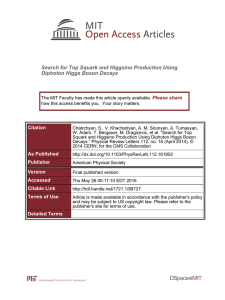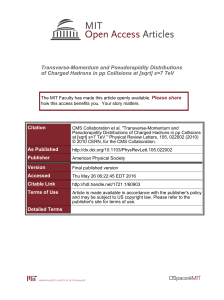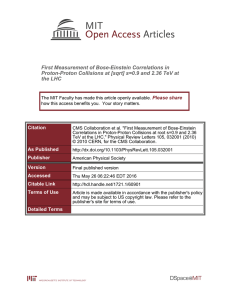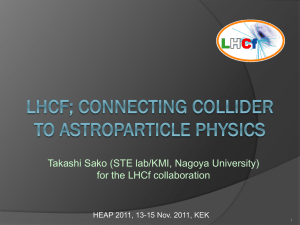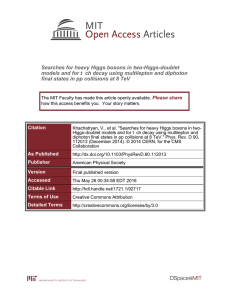Indications of Suppression of Excited Upsilon States in Please share
advertisement
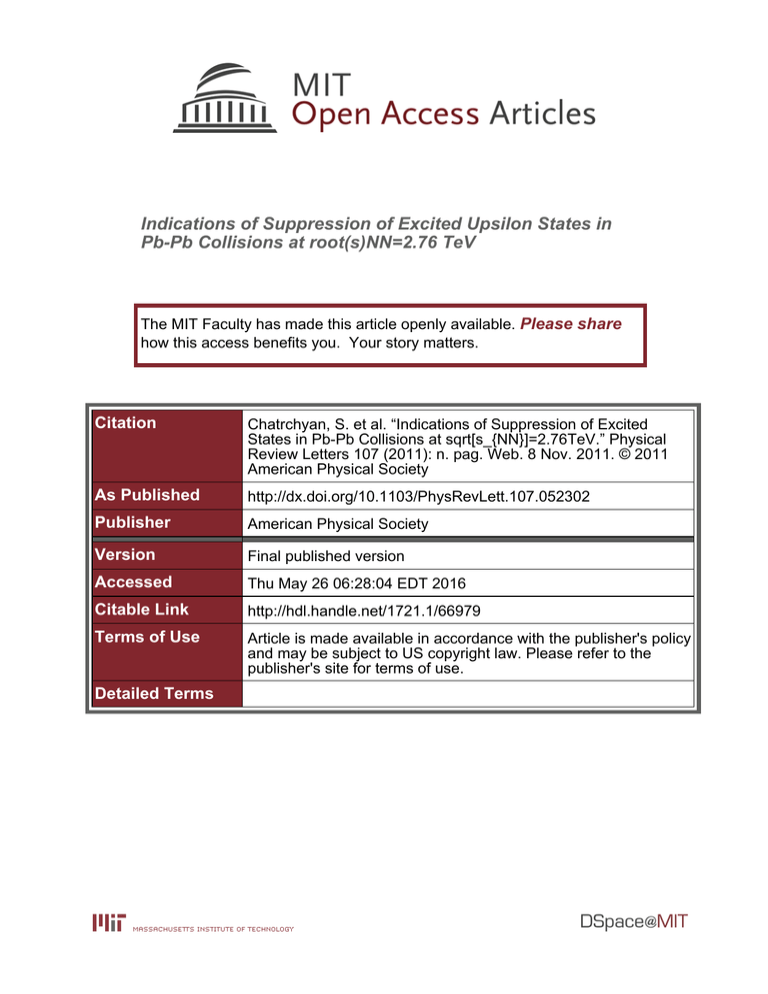
Indications of Suppression of Excited Upsilon States in
Pb-Pb Collisions at root(s)NN=2.76 TeV
The MIT Faculty has made this article openly available. Please share
how this access benefits you. Your story matters.
Citation
Chatrchyan, S. et al. “Indications of Suppression of Excited
States in Pb-Pb Collisions at sqrt[s_{NN}]=2.76TeV.” Physical
Review Letters 107 (2011): n. pag. Web. 8 Nov. 2011. © 2011
American Physical Society
As Published
http://dx.doi.org/10.1103/PhysRevLett.107.052302
Publisher
American Physical Society
Version
Final published version
Accessed
Thu May 26 06:28:04 EDT 2016
Citable Link
http://hdl.handle.net/1721.1/66979
Terms of Use
Article is made available in accordance with the publisher's policy
and may be subject to US copyright law. Please refer to the
publisher's site for terms of use.
Detailed Terms
PRL 107, 052302 (2011)
PHYSICAL REVIEW LETTERS
week ending
29 JULY 2011
pffiffiffiffiffiffiffiffi
Indications of Suppression of Excited States in Pb-Pb Collisions at sNN ¼ 2:76 TeV
S. Chatrchyan et al.*
(CMS Collaboration)
(Received 25 May 2011; published 28 July 2011)
A comparison of the relative yields of resonances in the þ decay channel in Pb-Pb and pp
collisions at a center-of-mass energy per nucleon pair of 2.76 TeV is performed with data collected with
the CMS detector at the LHC. Using muons of transverse momentum above 4 GeV=c and pseudorapidity
below 2.4, the double ratio of the ð2SÞ and ð3SÞ excited states to the ð1SÞ ground state in Pb-Pb
and pp collisions, ½ð2S þ 3SÞ=ð1SÞPb-Pb =½ð2S þ 3SÞ=ð1SÞpp , is found to be 0:31þ0:19
0:15 ðstatÞ 0:03ðsystÞ. The probability to obtain the measured value, or lower, if the true double ratio is unity, is
calculated to be less than 1%.
DOI: 10.1103/PhysRevLett.107.052302
PACS numbers: 25.75.Nq, 14.40.Pq
Quantum chromodynamics (QCD) predicts that strongly
interacting matter undergoes a phase transition to a deconfined state, often referred to as the quark-gluon plasma
(QGP), in which quarks and gluons are no longer bound
within hadrons. Calculations in lattice QCD [1,2] indicate
that the transition should occur at a critical temperature
Tc ’ 150–175 MeV, corresponding to an energy density
"c ’ 1 GeV=fm3 .
If the QGP is formed in heavy-ion collisions, it is
expected to screen the confining potential of heavy
quark-antiquark pairs [3], leading to the melting of charmonia (J= c ; c 0 ; c . . . ) and bottomonia (ð1SÞ; ð2SÞ;
ð3SÞ; b . . .). The melting temperature depends on the
binding energy of the quarkonium state. The ground states
J= c , and ð1SÞ, are expected to dissolve at significantly
higher temperatures than the more loosely bound excited
states. Quenched lattice QCD calculations [4,5] predict
that the ðnSÞ states melt at 1.2 Tc (3S), 1.6 Tc (2S), and
above 4 Tc (1S), while modern spectral-function approaches with complex potentials [6,7] favor somewhat
lower dissolution temperatures. This sequential melting
pattern is generally considered a ‘‘smoking-gun’’ signature
of the QCD deconfinement transition. However, a large
fraction of the observed ð1SÞ yield is due to decays of
heavier states (around 50% for the ð1SÞ [8]). Therefore
the melting of the excited states is expected to result in a
significant suppression of the observed ð1SÞ yield, even if
the medium is not hot enough to directly dissolve it.
Observations of a larger J= c and c ð2SÞ suppression in
heavy-ion collisions with respect to proton-nucleus collisions were reported by the NA38 [9], NA50 [10,11], and
NA60 [12] fixed-target experiments at the Super Proton
*Full author list given at the end of the article.
Published by the American Physical Society under the terms of
the Creative Commons Attribution 3.0 License. Further distribution of this work must maintain attribution to the author(s) and
the published article’s title, journal citation, and DOI.
0031-9007=11=107(5)=052302(15)
Synchrotron (SPS), respectively, in sulfur-uranium, leadlead, and indium-indium collisions, at center-of-mass
pffiffiffiffiffiffiffiffi
energies per nucleon pair ( sNN ) of about 20 GeV. The
PHENIX experiment, at the Relativistic Heavy Ion
Collider (RHIC), extended the J= c suppression measurepffiffiffiffiffiffiffiffi
ments to Au-Au collisions at sNN ¼ 200 GeV [13].
Recent results from ATLAS and CMS show J= c
suppression at LHC [14,15]. At RHIC, bottomonia production becomes measurable [16], though with limited integrated luminosities. PHENIX observed that the dimuon
yield in the mass region for minimum bias Au-Au
collisions is less than 64%, at the 90% confidence level,
of the value expected by extrapolating the proton-proton
yields [17].
A new era of detailed studies of the bottomonium family
in heavy-ion collisions has started at the Large Hadron
Collider (LHC). The measurement reported in this Letter is
performed with data recorded by the Compact Muon
Solenoid (CMS) experiment during the first lead-lead
(Pb-Pb) LHC run, at the end of 2010, and during the
pffiffiffiffiffiffiffiffi
proton-proton (pp) run of March 2011, both at sNN ¼
2:76 TeV. The integrated luminosity used in this analysis
corresponds to 7:28 b1 for Pb-Pb and 225 nb1 for pp
collisions, the latter corresponding approximately to the
equivalent nucleon-nucleon luminosity of the Pb-Pb run.
The momentum resolution of the CMS detector results in
well-resolved peaks in the dimuon mass spectrum. The
CMS Collaboration
has previously studied production in
pffiffiffi
pp data at s ¼ 7 TeV [18], using techniques to extract
the yields that are very similar to the ones used in the
study reported in this Letter.
A detailed description of the CMS detector can be found
in [19]. Its central feature is a superconducting solenoid
of 6 m internal diameter, providing a magnetic field of
3.8 T. Within the field volume are the silicon (Si) pixel
and strip tracker, the crystal electromagnetic calorimeter,
and the brass or scintillator hadron calorimeter. Muons
are measured in gas-ionization detectors embedded in
the steel return yoke. In addition, CMS has extensive
052302-1
Ó 2011 CERN, for the CMS Collaboration
PRL 107, 052302 (2011)
PHYSICAL REVIEW LETTERS
forward calorimetry, in particular, two steel or quartz-fiber
Čerenkov hadron forward (HF) calorimeters, which cover
the pseudorapidity range 2:9 < jj < 5:2.
In this analysis, states are identified through their
dimuon decay. The silicon pixel and strip tracker measures
charged-particle trajectories in the range jj < 2:5. The
tracker consists of 66 M pixel and 10 M strip detector
channels, providing a vertex resolution of 15 m in the
transverse plane. Muons are detected in the jj < 2:4
range, with detection planes based on three technologies:
drift tubes, cathode strip chambers, and resistive plate
chambers. Because of the strong magnetic field and the
fine granularity of the Si tracker, the muon transverse
momentum measurement (pT ) based on information from
the Si tracker alone has a resolution between 1% and 2%
for a typical muon in this analysis.
In both the Pb-Pb and pp runs, the events are selected by
the CMS two-level trigger. At the first, hardware level, two
independent muon candidates are required in the muon
detectors. No selection is made on momentum or pseudorapidity, but in the pp case more stringent quality requirements are imposed for each muon in order to reduce the
higher trigger rate. In both cases, the software-based
higher-level trigger accepts the lower-level decision without applying further criteria. The single-muon trigger efficiencies are measured from reconstructed J= c ! decays, for muons with pT > 4 GeV=c. The values of
these efficiencies, ð96:1 1:0Þ% in the Pb-Pb data set
and ð95:5 0:6Þ% in the pp data set, are consistent.
For the Pb-Pb data, events are preselected offline if
they contain a reconstructed primary vertex made of at
least two tracks, and a coincidence in both HF calorimeters
of energy deposits larger than 3 GeV in at least three
towers. These criteria reduce contributions from singlebeam interactions (e.g., beam-gas and beam-halo collisions
with the beam pipe), ultraperipheral electromagnetic
collisions, and cosmic-ray muons. A small fraction of the
most peripheral Pb-Pb collisions is not selected by these
requirements, which accept ð97 3Þ% of the hadronic
inelastic cross section [20]. For the pp run, a similar event
filter is applied, relaxing the HF coincidence to one tower
in each HF, with at least 3 GeV deposited. This filter
removes only 1% of the pp events satisfying the dimuon
trigger.
The muon offline reconstruction is seeded with ’ 99%
efficiency by tracks in the muon detectors, called standalone muons. These tracks are then matched to tracks
reconstructed in the Si tracker by means of an algorithm
optimized for the heavy-ion environment [21,22]. For
muons from decays the Si-tracking efficiency is
’ 85%. This efficiency is lower than in pp, as in Pb-Pb
the Si-track reconstruction is seeded by a greater number of
pixel hits to reduce the large number of random combinations arising from the high multiplicity of each event.
Combined fits of the muon and Si-tracker tracks are used
week ending
29 JULY 2011
to obtain the results presented in this Letter. The heavy-ion
dedicated reconstruction algorithm is applied to the pp
data in order to avoid potential biases.
Identical, very-loose selection criteria are applied to the
muons in the pp and Pb-Pb data. Their transverse (longitudinal) distance of closest approach from the event vertex
is required to be less than 3 (15) cm. Tracks are only kept if
they have 11 or more hits in the silicon tracker and the 2
per degree of freedom of the combined (tracker) track fit is
lower than 20 (4). The two muon trajectories are fit with a
common vertex constraint, and events are retained if the fit
2 probability is larger than 1%. This removes background
arising primarily from the displaced, semileptonic decays
of charm and bottom hadrons. As determined from Monte
Carlo simulation of the ð1SÞ signal, these selection criteria are found to reduce the efficiency by 3.9%, which is
consistent with the signal loss observed in both pp and PbPb data. The available event sample limits to 20 GeV=c the
dimuon transverse momentum range probed in this study.
Only muons with a transverse momentum (p
T ) higher
than 4 GeV=c are considered, resulting in a acceptance
of approximately 25% for the jy j < 2:4 rapidity range.
This requirement optimizes the significance of the ð1SÞ
signal in Pb-Pb data and is applied to both data sets. The
acceptance of a state depends on its mass, since the
excited states give rise to higher-momenta muons. In consequence, requiring higher p
T increases the acceptance for
the excited states relative to the ground state. In the corresponding analysis performed with the higher statistics
(3:1 pb1 ) 7 TeV data [18], looser criteria were applied
(p
T > 3:5 GeV=c and j j < 1:6, or pT > 2:5 GeV=c
and 1:6 < j j < 2:4), where is the muon pseudorapidity. The stricter (p
T > 4 GeV=c) requirements used
here enhance the ð2S þ 3SÞ=ð1SÞ yield ratio by
’ 60% in the pp data at 2.76 TeV. It was checked that,
applying identical pp reconstruction algorithms and p
T
requirements, the ð2S þ 3SÞ=ð1SÞ yield ratio is consistent, within statistical uncertainties, between the 2.76 and
7 TeV pp data sets [15].
The dimuon invariant-mass spectra with the selection
criteria applied are shown in Fig. 1 for the pp and Pb-Pb
data sets. Within the 7–14 GeV=c2 mass range, there are
561 (628) opposite-sign muon pairs in the pp (Pb-Pb) data
set. The three Y peaks are clearly observed in the pp case,
but the ð2SÞ and ð3SÞ are not visible over the residual
background in Pb-Pb collisions.
An extended unbinned maximum likelihood fit to the
two invariant-mass distributions of Fig. 1 is performed to
extract the yields, following the method described in [18].
The measured mass line shape of each state is parametrized by a ‘‘crystal ball’’ (CB) function, i.e., a Gaussian
resolution function with the lowside tail replaced by a
power law describing final-state radiation (FSR). Since
the three resonances partially overlap in the measured
dimuon mass, they are fit simultaneously. Therefore, the
052302-2
PHYSICAL REVIEW LETTERS
PRL 107, 052302 (2011)
80
a)
Events / ( 0.14 GeV/c2 )
70
CMS, pp, s = 2.76 TeV
µ
µ
p > 4 GeV/c, η < 2.4
T
pΥ
T
60
50
< 20 GeV/c
L int = 225 nb-1
40
30
20
10
0
7
8
9
10
11
12
13
14
µ µ invariant mass [GeV/c2]
Events / ( 0.14 GeV/c2 )
60
b)
CMS, Pb-Pb, sNN = 2.76 TeV
µ
µ
pT > 4 GeV/c, η < 2.4
50
pΥT < 20 GeV/c
40
Lint = 7.28 µb-1
30
20
10
0
7
8
9
10
11
12
13
14
µ µ invariant mass [GeV/c2]
FIG. 1 (color online). Dimuon invariant-mass distributions
pffiffiffiffiffiffiffiffi
from the pp (a) and Pb-Pb (b) data at sNN ¼ 2:76 TeV. The
same reconstruction algorithm and analysis criteria are applied
to both data sets, including a transverse momentum requirement
on single muons of p
T > 4 GeV=c. The solid lines show the
result of the fit described in the text.
probability distribution function (PDF) describing the
signal consists of three CB functions. In addition to the
three ðnSÞ yields, the ð1SÞ mass is the only parameter
left free, to accommodate a possible bias in the momentum
scale calibration. The mass ratios between the states are
fixed to their world average values [23] and the mass
resolution is forced to scale with the resonance mass.
The ð1SÞ resolution is fixed to the value estimated in
the simulation, 92 MeV=c2 , which is compatible with the
resolution obtained from both the Pb-Pb and pp data. The
lowside tail parameters are also fixed to the values obtained
via simulation. Finally, a second-order polynomial is
chosen to describe the background in the 7–14 GeV=c2
mass-fit range.
The quality of the unbinned fit is checked a posteriori by
comparing the obtained line shapes to the binned data of
Fig. 1. The 2 probabilities are 74% and 77%, respectively,
for pp and Pb-Pb.
The ratios of the observed (uncorrected) yields of the
ð2SÞ and ð3SÞ excited states to the ð1SÞ ground state
in the pp and Pb-Pb data are
week ending
29 JULY 2011
ð2S þ 3SÞ=ð1SÞjpp ¼ 0:78þ0:16
0:14 0:02;
(1)
ð2S þ 3SÞ=ð1SÞjPb-Pb ¼ 0:24þ0:13
0:12 0:02;
(2)
where the first uncertainty is statistical and the second is
systematic.
The systematic uncertainties are computed by varying
the line shape in the following ways: (1) the CB-tail
parameters are varied randomly according to their covariance matrix and within conservative values covering imperfect knowledge of the amount of detector material and
FSR in the underlying process; (2) the resolution is varied
by 5 MeV=c2 , which is a conservative variation given
the current understanding of the detector performance
and reasonable changes that can be anticipated in the
-resonance kinematics between pp and Pb-Pb data;
(3) the background shape is changed from quadratic to
linear while the mass range of the fit is varied from 6–15
to 8–12 GeV=c2 ; the observed root-mean-square of the
results is taken as the systematic uncertainty. The quadratic
sum of these three systematic uncertainties gives a relative
uncertainty on the ratio of 10% (3%) for the Pb-Pb
(pp) data.
The ratio of the ð2S þ 3SÞ=ð1SÞ ratios in Pb-Pb and
pp benefits from an almost complete cancellation of possible acceptance and/or efficiency differences among the
reconstructed resonances. A simultaneous fit to the pp and
Pb-Pb mass spectra gives the double ratio
ð2S þ 3SÞ=ð1SÞjPb-Pb
¼ 0:31þ0:19
0:15 ðstatÞ 0:03ðsystÞ;
ð2S þ 3SÞ=ð1SÞjpp
(3)
where the systematic uncertainty (9%) arises from varying
the line shape as described above in the simultaneous fit,
thus taking into account partial cancellations of systematic
effects.
The single-muon lower momentum requirement is
a posteriori varied from 3 to 5 GeV=c in steps of
500 MeV=c, and it is found that pT requirements other
than 4 GeV=c produce lower values of the double ratio.
Fitting the pp and Pb-Pb spectra with free and independent
mass resolution parameters leads to an increase of the
double ratio by 15%.
To evaluate possible imperfect cancellations of acceptance and efficiency effects in the double ratio, a full [24]
detector simulation is performed. The effect of the higher
Pb-Pb underlying event activity is accounted for by embedding, at the level of detector signals, ð1SÞ and ð2SÞ
decays simulated by PYTHIA 6.424 [25] in Pb-Pb events
simulated with HYDJET [26]. Track characteristics, such
as the number of hits and the 2 of the track fit, have
similar distributions in data and simulation. As mentioned
above, the trigger efficiency is evaluated with data, by
using single-muon-triggered data events, and reconstructing J= c signal with and without the dimuon trigger
052302-3
PRL 107, 052302 (2011)
PHYSICAL REVIEW LETTERS
requirement. The same exercise is carried out with the
simulation and it agrees with the efficiency measured in
data at the 2% level. The track efficiency in the silicon
detector is measured with standalone muons, applying all
selection criteria. The efficiencies in data and simulation
agree within the 4% statistical uncertainty of the efficiency
determined from data.
The difference in reconstruction and selection efficiencies between the states is less than 5% and the relative
variation with charged-particle multiplicity is about 10%
from pp to central Pb-Pb collisions, producing a maximum
change of 0.5% on the double ratio. The good agreement
between single-muon trigger efficiencies extracted from
data for the pp and Pb-Pb trigger requirements, applied
to the ð1SÞ and ð2SÞ trigger efficiencies derived from
simulation, leads to a negligible effect on the double ratio.
The single-muon trigger efficiencies extracted from data
agree within 1.5% for the pp and Pb-Pb trigger requirements, and the ð1SÞ and ð2SÞ trigger efficiencies agree
within 3%, according to simulation: the potential trigger
bias on the double ratio is negligible. Even doubling the
size of these variations, to take the ð3SÞ into account,
leads to a negligible change in the double ratio. The
magnitudes of the statistical and systematic uncertainties
on the double ratio, respectively, 55% and 9%, are significantly larger than the systematic uncertainties associated
with possible imperfect cancellation of acceptance and
efficiency effects. Therefore no additional uncertainty
from these sources is applied.
Finally, using an ensemble of 1 106 pseudoexperiments, generated with the signal line shape obtained
from the pp data [Fig. 1(a)], the background line shapes
from both data sets, and a double ratio [Eq. (3)] equal to
unity within statistical and systematic uncertainties, the
probability of finding the measured value of 0.31 or below
is estimated to be 0.9%. In other words, in the absence of a
suppression due to physics mechanisms, the probability of
a downward departure of the ratio from unity of this
significance or greater is 0.9%, i.e., that corresponding
to 2.4 sigma in a one-tailed integral of a Gaussian
distribution.
Other studies from the CMS experiment show that the
ð1SÞ is suppressed by about 40% [15] in minimum bias
pffiffiffiffiffiffiffiffi
Pb-Pb collisions at sNN ¼ 2:76 TeV. Since a large fraction of the ð1SÞ yield arises from decays of heavier
bottomonium states [8], this ð1SÞ suppression could be
indirectly caused by the suppression of the excited states
reported in this Letter.
Production yields of quarkonium states can also be
modified, from pp to Pb-Pb collisions, in the absence of
QGP formation, by cold nuclear matter effects [27].
However, such effects should have a small impact on the
double ratio reported here. The nuclear modifications of
the parton distribution functions (shadowing) should have
an equivalent effect on the three states, because their
week ending
29 JULY 2011
production involves very similar partons, canceling in the
ratio, at least to first order. The same should happen to any
other initial-state nuclear effect. In principle, the larger and
more loosely bound excited quarkonium states are more
likely to be broken up by final-state interactions while
traversing the nuclear matter, something extensively
studied in the context of charmonium suppression at lower
energies [28]. This ‘‘nuclear absorption’’ becomes weaker
with increasing energy, and should be negligible at the
LHC. At RHIC energies, the STAR experiment [29] has
reported a ð1S þ 2S þ 3SÞ yield in d-Au collisions of
0:78 0:28 0:20 times the yield expected by scaling pp
collisions, compatible with the absence of absorption.
Furthermore, the double ratio presented here would only
be sensitive to a difference between the nuclear dependencies of the three states and already at much lower energies
the Fermilab E772 experiment observed [30], in protonnucleus collisions, no such difference, within uncertainties,
between the ð1SÞ and the sum ð2S þ 3SÞ.
Future high-statistics heavy-ion and proton-nucleus runs
at the LHC will provide further quarkonia measurements,
which should help disentangle nuclear from medium
effects and aid the interpretation of the result reported in
this Letter.
In summary, a comparison of the relative yields of resonances has been performed in Pb-Pb and pp collisions
at the same center-of-mass energy per nucleon pair of
2.76 TeV. The double ratio of the ð2SÞ and ð3SÞ excited
states to the ð1SÞ ground state in Pb-Pb and pp collisions,
½ð2Sþ3SÞ=ð1SÞPb-Pb =½ð2Sþ3SÞ=ð1SÞpp , is found
to be 0:31þ0:19
0:15 ðstatÞ 0:03ðsystÞ, for muons of pT >
4 GeV=c and jj < 2:4. The probability to obtain the
measured value, or lower, if the true double ratio is unity,
has been calculated to be less than 1%.
We wish to congratulate our colleagues in the CERN
accelerator departments for the excellent performance of
the LHC machine. We thank the technical and administrative staff at CERN and other CMS institutes, and acknowledge support from: FMSR (Austria); FNRS and FWO
(Belgium); CNPq, CAPES, FAPERJ, and FAPESP
(Brazil); MES (Bulgaria); CERN; CAS, MoST, and
NSFC (China); COLCIENCIAS (Colombia); MSES
(Croatia); RPF (Cyprus); Academy of Sciences and
NICPB (Estonia); Academy of Finland, ME, and HIP
(Finland); CEA and CNRS/IN2P3 (France); BMBF,
DFG, and HGF (Germany); GSRT (Greece); OTKA an
NKTH (Hungary); DAE and DST (India); IPM (Iran);
SFI (Ireland); INFN (Italy); NRF and WCU (Korea);
LAS (Lithuania); CINVESTAV, CONACYT, SEP, and
UASLP-FAI (Mexico); PAEC (Pakistan); SCSR (Poland);
FCT (Portugal); JINR (Armenia, Belarus, Georgia,
Ukraine, Uzbekistan); MST and MAE (Russia); MSTD
(Serbia); MICINN and CPAN (Spain); Swiss Funding
Agencies (Switzerland); NSC (Taipei); TUBITAK and
TAEK (Turkey); STFC (United Kingdom); DOE and
052302-4
PRL 107, 052302 (2011)
PHYSICAL REVIEW LETTERS
NSF (U.S.). Individuals have received support from the
Marie-Curie programme and the European Research
Council (European Union); the Leventis Foundation; the
A. P. Sloan Foundation; the Alexander von Humboldt
Foundation; the Associazione per lo Sviluppo Scientifico
e Tecnologico del Piemonte (Italy); the Belgian Federal
Science Policy Office; the Fonds pour la Formation à
la Recherche dans l’industrie et dans l’Agriculture
(FRIA-Belgium); and the Agentschap voor Innovatie door
Wetenschap en Technologie (IWT-Belgium).
[1] F. Karsch, Lect. Notes Phys. 583, 209 (2002).
[2] S. Borsanyi et al. (Wuppertal-Budapest Collaboration),
J. High Energy Phys. 09 (2010) 073.
[3] T. Matsui and H. Satz, Phys. Lett. B 178, 416 (1986).
[4] H. Satz, J. Phys. G 32, R25 (2006).
[5] C.-Y. Wong, Phys. Rev. C 72, 034906 (2005).
[6] A. Mocsy and P. Petreczky, Phys. Rev. Lett. 99, 211602
(2007).
[7] C. Miao, A. Mocsy, and P. Petreczky, Nucl. Phys. A 855,
125 (2011).
[8] A. Affolder et al. (CDF Collaboration), Phys. Rev. Lett.
84, 2094 (2000).
[9] C. Baglin et al. (NA38 Collaboration), Phys. Lett. B 345,
617 (1995).
[10] B. Alessandro et al. (NA50 Collaboration), Eur. Phys. J. C
39, 335 (2005).
[11] B. Alessandro et al. (NA50 Collaboration), Eur. Phys. J. C
49, 559 (2007).
[12] R. Arnaldi et al. (NA60 Collaboration), Phys. Rev. Lett.
99, 132302 (2007).
[13] A. Adare et al. (PHENIX Collaboration), Phys. Rev. Lett.
98, 232301 (2007).
week ending
29 JULY 2011
[14] G. Aad et al. (ATLAS Collaboration), Phys. Lett. B 697,
294 (2011).
[15] CMS Collaboration, CMS Physics Analysis Summary,
CMS-PAS-HIN-10-006, 2011, http://cdsweb.cern.ch/
record/1353586.
[16] B. I. Abelev et al. (STAR Collaboration), Phys. Rev. D 82,
012004 (2010).
[17] E. T. Atomssa (PHENIX Collaboration), Nucl. Phys.
A830, 331c (2009).
[18] V. Khachatryan et al. (CMS Collaboration), Phys. Rev. D
83, 112004 (2011).
[19] S. Chatrchyan et al. (CMS Collaboration), JINST 3,
S08004 (2008).
[20] CMS Collaboration, arXiv:1102.1957 [Phys. Rev. C
(to be published)].
[21] C. Roland (CMS Collaboration), Nucl. Instrum. Methods
Phys. Res., Sect. A 566, 123 (2006).
[22] D. d’Enterria et al. (CMS Collaboration), J. Phys. G 34,
2307 (2007).
[23] K. Nakamura et al. (Particle Data Group), J. Phys. G 37,
075021 (2010).
[24] S. Agostinelli et al. (GEANT4 Collaboration), Nucl.
Instrum. Methods Phys. Res., Sect. A 506, 250 (2003).
[25] T. Sjöstrand, S. Mrenna, and P. Skands, J. High Energy
Phys. 05 (2006) 026.
[26] I. P. Lokhtin and A. M. Snigirev, Eur. Phys. J. C 45, 211
(2006).
[27] R. Vogt, Phys. Rev. C 81, 044903 (2010).
[28] C. Lourenco, R. Vogt, and H. K. Woehri, J. High Energy
Phys. 02 (2009) 014.
[29] R. Reed (STAR Collaboration), J. Phys. Conf. Ser. 270,
012026 (2011).
[30] D. M. Alde et al., Phys. Rev. Lett. 66, 2285 (1991).
S. Chatrchyan,1 V. Khachatryan,1 A. M. Sirunyan,1 A. Tumasyan,1 W. Adam,2 T. Bergauer,2 M. Dragicevic,2 J. Erö,2
C. Fabjan,2 M. Friedl,2 R. Frühwirth,2 V. M. Ghete,2 J. Hammer,2,b S. Hänsel,2 M. Hoch,2 N. Hörmann,2 J. Hrubec,2
M. Jeitler,2 W. Kiesenhofer,2 M. Krammer,2 D. Liko,2 I. Mikulec,2 M. Pernicka,2 B. Rahbaran,2 H. Rohringer,2
R. Schöfbeck,2 J. Strauss,2 A. Taurok,2 F. Teischinger,2 P. Wagner,2 W. Waltenberger,2 G. Walzel,2 E. Widl,2
C.-E. Wulz,2 V. Mossolov,3 N. Shumeiko,3 J. Suarez Gonzalez,3 S. Bansal,4 L. Benucci,4 E. A. De Wolf,4 X. Janssen,4
J. Maes,4 T. Maes,4 L. Mucibello,4 S. Ochesanu,4 B. Roland,4 R. Rougny,4 M. Selvaggi,4 H. Van Haevermaet,4
P. Van Mechelen,4 N. Van Remortel,4 F. Blekman,5 S. Blyweert,5 J. D’Hondt,5 O. Devroede,5 R. Gonzalez Suarez,5
A. Kalogeropoulos,5 M. Maes,5 W. Van Doninck,5 P. Van Mulders,5 G. P. Van Onsem,5 I. Villella,5 O. Charaf,6
B. Clerbaux,6 G. De Lentdecker,6 V. Dero,6 A. P. R. Gay,6 G. H. Hammad,6 T. Hreus,6 P. E. Marage,6 L. Thomas,6
C. Vander Velde,6 P. Vanlaer,6 V. Adler,7 A. Cimmino,7 S. Costantini,7 M. Grunewald,7 B. Klein,7 J. Lellouch,7
A. Marinov,7 J. Mccartin,7 D. Ryckbosch,7 F. Thyssen,7 M. Tytgat,7 L. Vanelderen,7 P. Verwilligen,7 S. Walsh,7
N. Zaganidis,7 S. Basegmez,8 G. Bruno,8 J. Caudron,8 L. Ceard,8 E. Cortina Gil,8 J. De Favereau De Jeneret,8
C. Delaere,8 D. Favart,8 A. Giammanco,8 G. Grégoire,8 J. Hollar,8 V. Lemaitre,8 J. Liao,8 O. Militaru,8 C. Nuttens,8
S. Ovyn,8 D. Pagano,8 A. Pin,8 K. Piotrzkowski,8 N. Schul,8 N. Beliy,9 T. Caebergs,9 E. Daubie,9 G. A. Alves,10
L. Brito,10 D. De Jesus Damiao,10 M. E. Pol,10 M. H. G. Souza,10 W. L. Aldá Júnior,11 W. Carvalho,11
E. M. Da Costa,11 C. De Oliveira Martins,11 S. Fonseca De Souza,11 L. Mundim,11 H. Nogima,11 V. Oguri,11
W. L. Prado Da Silva,11 A. Santoro,11 S. M. Silva Do Amaral,11 A. Sznajder,11 C. A. Bernardes,12,c F. A. Dias,12
T. R. Fernandez Perez Tomei,12 E. M. Gregores,12,c C. Lagana,12 F. Marinho,12 P. G. Mercadante,12,c S. F. Novaes,12
Sandra S. Padula,12 N. Darmenov,13,b V. Genchev,13,b P. Iaydjiev,13,b S. Piperov,13 M. Rodozov,13 S. Stoykova,13
052302-5
PRL 107, 052302 (2011)
PHYSICAL REVIEW LETTERS
week ending
29 JULY 2011
G. Sultanov,13 V. Tcholakov,13 R. Trayanov,13 A. Dimitrov,14 R. Hadjiiska,14 A. Karadzhinova,14 V. Kozhuharov,14
L. Litov,14 M. Mateev,14 B. Pavlov,14 P. Petkov,14 J. G. Bian,15 G. M. Chen,15 H. S. Chen,15 C. H. Jiang,15 D. Liang,15
S. Liang,15 X. Meng,15 J. Tao,15 J. Wang,15 J. Wang,15 X. Wang,15 Z. Wang,15 H. Xiao,15 M. Xu,15 J. Zang,15
Z. Zhang,15 Y. Ban,16 S. Guo,16 Y. Guo,16 W. Li,16 Y. Mao,16 S. J. Qian,16 H. Teng,16 B. Zhu,16 W. Zou,16
A. Cabrera,17 B. Gomez Moreno,17 A. A. Ocampo Rios,17 A. F. Osorio Oliveros,17 J. C. Sanabria,17 N. Godinovic,18
D. Lelas,18 K. Lelas,18 R. Plestina,18,d D. Polic,18 I. Puljak,18 Z. Antunovic,19 M. Dzelalija,19 V. Brigljevic,20
S. Duric,20 K. Kadija,20 S. Morovic,20 A. Attikis,21 M. Galanti,21 J. Mousa,21 C. Nicolaou,21 F. Ptochos,21
P. A. Razis,21 M. Finger,22 M. Finger, Jr.,22 Y. Assran,23,e A. Ellithi Kamel,23 S. Khalil,23,f M. A. Mahmoud,23,g
A. Hektor,24 M. Kadastik,24 M. Müntel,24 M. Raidal,24 L. Rebane,24 A. Tiko,24 V. Azzolini,25 P. Eerola,25 G. Fedi,25
S. Czellar,26 J. Härkönen,26 A. Heikkinen,26 V. Karimäki,26 R. Kinnunen,26 M. J. Kortelainen,26 T. Lampén,26
K. Lassila-Perini,26 S. Lehti,26 T. Lindén,26 P. Luukka,26 T. Mäenpää,26 E. Tuominen,26 J. Tuominiemi,26
E. Tuovinen,26 D. Ungaro,26 L. Wendland,26 K. Banzuzi,27 A. Karjalainen,27 A. Korpela,27 T. Tuuva,27 D. Sillou,28
M. Besancon,29 S. Choudhury,29 M. Dejardin,29 D. Denegri,29 B. Fabbro,29 J. L. Faure,29 F. Ferri,29 S. Ganjour,29
F. X. Gentit,29 A. Givernaud,29 P. Gras,29 G. Hamel de Monchenault,29 P. Jarry,29 E. Locci,29 J. Malcles,29
M. Marionneau,29 L. Millischer,29 J. Rander,29 A. Rosowsky,29 I. Shreyber,29 M. Titov,29 P. Verrecchia,29
S. Baffioni,30 F. Beaudette,30 L. Benhabib,30 L. Bianchini,30 M. Bluj,30,h C. Broutin,30 P. Busson,30 C. Charlot,30
T. Dahms,30 L. Dobrzynski,30 S. Elgammal,30 R. Granier de Cassagnac,30 M. Haguenauer,30 P. Miné,30 C. Mironov,30
C. Ochando,30 P. Paganini,30 D. Sabes,30 R. Salerno,30 Y. Sirois,30 C. Thiebaux,30 B. Wyslouch,30,i A. Zabi,30
J.-L. Agram,31,j J. Andrea,31 D. Bloch,31 D. Bodin,31 J.-M. Brom,31 M. Cardaci,31 E. C. Chabert,31 C. Collard,31
E. Conte,31,j F. Drouhin,31,j C. Ferro,31 J.-C. Fontaine,31,j D. Gelé,31 U. Goerlach,31 S. Greder,31 P. Juillot,31
M. Karim,31,j A.-C. Le Bihan,31 Y. Mikami,31 P. Van Hove,31 F. Fassi,32 D. Mercier,32 C. Baty,33 S. Beauceron,33
N. Beaupere,33 M. Bedjidian,33 O. Bondu,33 G. Boudoul,33 D. Boumediene,33 H. Brun,33 J. Chasserat,33
R. Chierici,33 D. Contardo,33 P. Depasse,33 H. El Mamouni,33 J. Fay,33 S. Gascon,33 B. Ille,33 T. Kurca,33
T. Le Grand,33 M. Lethuillier,33 L. Mirabito,33 S. Perries,33 V. Sordini,33 S. Tosi,33 Y. Tschudi,33 P. Verdier,33
D. Lomidze,34 G. Anagnostou,35 S. Beranek,35 M. Edelhoff,35 L. Feld,35 N. Heracleous,35 O. Hindrichs,35
R. Jussen,35 K. Klein,35 J. Merz,35 N. Mohr,35 A. Ostapchuk,35 A. Perieanu,35 F. Raupach,35 J. Sammet,35 S. Schael,35
D. Sprenger,35 H. Weber,35 M. Weber,35 B. Wittmer,35 M. Ata,36 E. Dietz-Laursonn,36 M. Erdmann,36 T. Hebbeker,36
C. Heidemann,36 A. Hinzmann,36 K. Hoepfner,36 T. Klimkovich,36 D. Klingebiel,36 P. Kreuzer,36 D. Lanske,36,a
J. Lingemann,36 C. Magass,36 M. Merschmeyer,36 A. Meyer,36 P. Papacz,36 H. Pieta,36 H. Reithler,36 S. A. Schmitz,36
L. Sonnenschein,36 J. Steggemann,36 D. Teyssier,36 M. Bontenackels,37 M. Davids,37 M. Duda,37 G. Flügge,37
H. Geenen,37 M. Giffels,37 W. Haj Ahmad,37 D. Heydhausen,37 F. Hoehle,37 B. Kargoll,37 T. Kress,37 Y. Kuessel,37
A. Linn,37 A. Nowack,37 L. Perchalla,37 O. Pooth,37 J. Rennefeld,37 P. Sauerland,37 A. Stahl,37 M. Thomas,37
D. Tornier,37 M. H. Zoeller,37 M. Aldaya Martin,38 W. Behrenhoff,38 U. Behrens,38 M. Bergholz,38,k A. Bethani,38
K. Borras,38 A. Cakir,38 A. Campbell,38 E. Castro,38 D. Dammann,38 G. Eckerlin,38 D. Eckstein,38 A. Flossdorf,38
G. Flucke,38 A. Geiser,38 J. Hauk,38 H. Jung,38,b M. Kasemann,38 I. Katkov,38,l P. Katsas,38 C. Kleinwort,38
H. Kluge,38 A. Knutsson,38 M. Krämer,38 D. Krücker,38 E. Kuznetsova,38 W. Lange,38 W. Lohmann,38,k R. Mankel,38
M. Marienfeld,38 I.-A. Melzer-Pellmann,38 A. B. Meyer,38 J. Mnich,38 A. Mussgiller,38 J. Olzem,38 A. Petrukhin,38
D. Pitzl,38 A. Raspereza,38 A. Raval,38 M. Rosin,38 R. Schmidt,38,k T. Schoerner-Sadenius,38 N. Sen,38
A. Spiridonov,38 M. Stein,38 J. Tomaszewska,38 R. Walsh,38 C. Wissing,38 C. Autermann,39 V. Blobel,39
S. Bobrovskyi,39 J. Draeger,39 H. Enderle,39 U. Gebbert,39 M. Görner,39 T. Hermanns,39 K. Kaschube,39
G. Kaussen,39 H. Kirschenmann,39 R. Klanner,39 J. Lange,39 B. Mura,39 S. Naumann-Emme,39 F. Nowak,39
N. Pietsch,39 C. Sander,39 H. Schettler,39 P. Schleper,39 E. Schlieckau,39 M. Schröder,39 T. Schum,39 H. Stadie,39
G. Steinbrück,39 J. Thomsen,39 C. Barth,40 J. Bauer,40 J. Berger,40 V. Buege,40 T. Chwalek,40 W. De Boer,40
A. Dierlamm,40 G. Dirkes,40 M. Feindt,40 J. Gruschke,40 C. Hackstein,40 F. Hartmann,40 M. Heinrich,40 H. Held,40
K. H. Hoffmann,40 S. Honc,40 J. R. Komaragiri,40 T. Kuhr,40 D. Martschei,40 S. Mueller,40 Th. Müller,40 M. Niegel,40
O. Oberst,40 A. Oehler,40 J. Ott,40 T. Peiffer,40 G. Quast,40 K. Rabbertz,40 F. Ratnikov,40 N. Ratnikova,40 M. Renz,40
C. Saout,40 A. Scheurer,40 P. Schieferdecker,40 F.-P. Schilling,40 G. Schott,40 H. J. Simonis,40 F. M. Stober,40
D. Troendle,40 J. Wagner-Kuhr,40 T. Weiler,40 M. Zeise,40 V. Zhukov,40,l E. B. Ziebarth,40 G. Daskalakis,41
T. Geralis,41 S. Kesisoglou,41 A. Kyriakis,41 D. Loukas,41 I. Manolakos,41 A. Markou,41 C. Markou,41
C. Mavrommatis,41 E. Ntomari,41 E. Petrakou,41 L. Gouskos,42 T. J. Mertzimekis,42 A. Panagiotou,42 E. Stiliaris,42
I. Evangelou,43 C. Foudas,43 P. Kokkas,43 N. Manthos,43 I. Papadopoulos,43 V. Patras,43 F. A. Triantis,43 A. Aranyi,44
052302-6
PRL 107, 052302 (2011)
PHYSICAL REVIEW LETTERS
week ending
29 JULY 2011
G. Bencze,44 L. Boldizsar,44 C. Hajdu,44,b P. Hidas,44 D. Horvath,44,m A. Kapusi,44 K. Krajczar,44,n F. Sikler,44,b
G. I. Veres,44,n G. Vesztergombi,44,n N. Beni,45 J. Molnar,45 J. Palinkas,45 Z. Szillasi,45 V. Veszpremi,45 P. Raics,46
Z. L. Trocsanyi,46 B. Ujvari,46 S. B. Beri,47 V. Bhatnagar,47 N. Dhingra,47 R. Gupta,47 M. Jindal,47 M. Kaur,47
J. M. Kohli,47 M. Z. Mehta,47 N. Nishu,47 L. K. Saini,47 A. Sharma,47 A. P. Singh,47 J. Singh,47 S. P. Singh,47
S. Ahuja,48 B. C. Choudhary,48 P. Gupta,48 S. Jain,48 A. Kumar,48 A. Kumar,48 M. Naimuddin,48 K. Ranjan,48
R. K. Shivpuri,48 S. Banerjee,49 S. Bhattacharya,49 S. Dutta,49 B. Gomber,49 S. Jain,49 R. Khurana,49 S. Sarkar,49
R. K. Choudhury,50 D. Dutta,50 S. Kailas,50 V. Kumar,50 P. Mehta,50 A. K. Mohanty,50,b L. M. Pant,50 P. Shukla,50
T. Aziz,51 M. Guchait,51,o A. Gurtu,51 M. Maity,51,p D. Majumder,51 G. Majumder,51 K. Mazumdar,51
G. B. Mohanty,51 A. Saha,51 K. Sudhakar,51 N. Wickramage,51 S. Banerjee,52 S. Dugad,52 N. K. Mondal,52
H. Arfaei,53 H. Bakhshiansohi,53,q S. M. Etesami,53 A. Fahim,53,q M. Hashemi,53 H. Hesari,53 A. Jafari,53,q
M. Khakzad,53 A. Mohammadi,53,r M. Mohammadi Najafabadi,53 S. Paktinat Mehdiabadi,53 B. Safarzadeh,53
M. Zeinali,53,s M. Abbrescia,54a,54b L. Barbone,54a,54b C. Calabria,54a,54b A. Colaleo,54a D. Creanza,54a,54c
N. De Filippis,54a,54c,b M. De Palma,54a,54b L. Fiore,54a G. Iaselli,54a,54c L. Lusito,54a,54b G. Maggi,54a,54c
M. Maggi,54a N. Manna,54a,54b B. Marangelli,54a,54b S. My,54a,54c S. Nuzzo,54a,54b N. Pacifico,54a,54b G. A. Pierro,54a
A. Pompili,54a,54b G. Pugliese,54a,54c F. Romano,54a,54c G. Roselli,54a,54b G. Selvaggi,54a,54b L. Silvestris,54a
R. Trentadue,54a S. Tupputi,54a,54b G. Zito,54a G. Abbiendi,55a A. C. Benvenuti,55a D. Bonacorsi,55a
S. Braibant-Giacomelli,55a,55b L. Brigliadori,55a P. Capiluppi,55a,55b A. Castro,55a,55b F. R. Cavallo,55a
M. Cuffiani,55a,55b G. M. Dallavalle,55a F. Fabbri,55a A. Fanfani,55a,55b D. Fasanella,55a P. Giacomelli,55a
M. Giunta,55a C. Grandi,55a S. Marcellini,55a G. Masetti,55b M. Meneghelli,55a,55b A. Montanari,55a
F. L. Navarria,55a,55b F. Odorici,55a A. Perrotta,55a F. Primavera,55a A. M. Rossi,55a,55b T. Rovelli,55a,55b
G. Siroli,55a,55b R. Travaglini,55a,55b S. Albergo,56a,56b G. Cappello,56a,56b M. Chiorboli,56a,56b,b S. Costa,56a,56b
A. Tricomi,56a,56b C. Tuve,56a,56b G. Barbagli,57a V. Ciulli,57a,57b C. Civinini,57a R. D’Alessandro,57a,57b
E. Focardi,57a,57b S. Frosali,57a,57b E. Gallo,57a S. Gonzi,57a,57b P. Lenzi,57a,57b M. Meschini,57a S. Paoletti,57a
G. Sguazzoni,57a A. Tropiano,57a,b L. Benussi,58 S. Bianco,58 S. Colafranceschi,58,t F. Fabbri,58 D. Piccolo,58
P. Fabbricatore,59 R. Musenich,59 A. Benaglia,60a,60b F. De Guio,60a,60b,b L. Di Matteo,60a,60b S. Gennai,60a,b
A. Ghezzi,60a,60b S. Malvezzi,60a A. Martelli,60a,60b A. Massironi,60a,60b D. Menasce,60a L. Moroni,60a
M. Paganoni,60a,60b D. Pedrini,60a S. Ragazzi,60a,60b N. Redaelli,60a S. Sala,60a T. Tabarelli de Fatis,60a,60b
S. Buontempo,61a C. A. Carrillo Montoya,61a,b N. Cavallo,61a,u A. De Cosa,61a,61b F. Fabozzi,61a,u A. O. M. Iorio,61a,b
L. Lista,61a M. Merola,61a,61b P. Paolucci,61a P. Azzi,62a N. Bacchetta,62a P. Bellan,62a,62b D. Bisello,62a,62b
A. Branca,62a R. Carlin,62a,62b P. Checchia,62a T. Dorigo,62a U. Dosselli,62a F. Fanzago,62a F. Gasparini,62a,62b
U. Gasparini,62a,62b A. Gozzelino,62a S. Lacaprara,62a I. Lazzizzera,62a,62c M. Margoni,62a,62b M. Mazzucato,62a
A. T. Meneguzzo,62a,62b M. Nespolo,62a,b L. Perrozzi,62a,b N. Pozzobon,62a,62b P. Ronchese,62a,62b F. Simonetto,62a,62b
E. Torassa,62a M. Tosi,62a,62b S. Vanini,62a,62b P. Zotto,62a,62b G. Zumerle,62a,62b P. Baesso,63a,63b U. Berzano,63a
S. P. Ratti,63a,63b C. Riccardi,63a,63b P. Torre,63a,63b P. Vitulo,63a,63b C. Viviani,63a,63b M. Biasini,64a,64b G. M. Bilei,64a
B. Caponeri,64a,64b L. Fanò,64a,64b P. Lariccia,64a,64b A. Lucaroni,64a,64b,b G. Mantovani,64a,64b M. Menichelli,64a
A. Nappi,64a,64b F. Romeo,64a,64b A. Santocchia,64a,64b S. Taroni,64a,64b,b M. Valdata,64a,64b P. Azzurri,65a,65c
G. Bagliesi,65a J. Bernardini,65a,65b T. Boccali,65a,b G. Broccolo,65a,65c R. Castaldi,65a R. T. D’Agnolo,65a,65c
R. Dell’Orso,65a F. Fiori,65a,65b L. Foà,65a,65c A. Giassi,65a A. Kraan,65a F. Ligabue,65a,65c T. Lomtadze,65a
L. Martini,65a,v A. Messineo,65a,65b F. Palla,65a G. Segneri,65a A. T. Serban,65a P. Spagnolo,65a R. Tenchini,65a
G. Tonelli,65a,65b,b A. Venturi,65a,b P. G. Verdini,65a L. Barone,66a,66b F. Cavallari,66a D. Del Re,66a,66b
E. Di Marco,66a,66b M. Diemoz,66a D. Franci,66a,66b M. Grassi,66a,b E. Longo,66a,66b P. Meridiani,66a
S. Nourbakhsh,66a G. Organtini,66a,66b F. Pandolfi,66a,66b,b R. Paramatti,66a S. Rahatlou,66a,66b C. Rovelli,66a,b
N. Amapane,67a,67b R. Arcidiacono,67a,67c S. Argiro,67a,67b M. Arneodo,67a,67c C. Biino,67a C. Botta,67a,67b,b
N. Cartiglia,67a R. Castello,67a,67b M. Costa,67a,67b N. Demaria,67a A. Graziano,67a,67b,b C. Mariotti,67a
M. Marone,67a,67b S. Maselli,67a E. Migliore,67a,67b G. Mila,67a,67b V. Monaco,67a,67b M. Musich,67a,67b
M. M. Obertino,67a,67c N. Pastrone,67a M. Pelliccioni,67a,67b A. Potenza,67a,67b A. Romero,67a,67b M. Ruspa,67a,67c
R. Sacchi,67a,67b V. Sola,67a,67b A. Solano,67a,67b A. Staiano,67a A. Vilela Pereira,67a S. Belforte,68a F. Cossutti,68a
G. Della Ricca,68a,68b B. Gobbo,68a D. Montanino,68a,68b A. Penzo,68a S. G. Heo,69 S. K. Nam,69 S. Chang,70
J. Chung,70 D. H. Kim,70 G. N. Kim,70 J. E. Kim,70 D. J. Kong,70 H. Park,70 S. R. Ro,70 D. C. Son,70 T. Son,70
Zero Kim,71 J. Y. Kim,71 S. Song,71 S. Choi,72 B. Hong,72 M. Jo,72 H. Kim,72 J. H. Kim,72 T. J. Kim,72 K. S. Lee,72
D. H. Moon,72 S. K. Park,72 K. S. Sim,72 M. Choi,73 S. Kang,73 H. Kim,73 C. Park,73 I. C. Park,73 S. Park,73 G. Ryu,73
052302-7
PRL 107, 052302 (2011)
PHYSICAL REVIEW LETTERS
week ending
29 JULY 2011
Y. Choi,74 Y. K. Choi,74 J. Goh,74 M. S. Kim,74 J. Lee,74 S. Lee,74 H. Seo,74 I. Yu,74 M. J. Bilinskas,75 I. Grigelionis,75
M. Janulis,75 D. Martisiute,75 P. Petrov,75 T. Sabonis,75 H. Castilla-Valdez,76 E. De La Cruz-Burelo,76
I. Heredia-de La Cruz,76 R. Lopez-Fernandez,76 R. Magaña Villalba,76 A. Sánchez-Hernández,76
L. M. Villasenor-Cendejas,76 S. Carrillo Moreno,77 F. Vazquez Valencia,77 H. A. Salazar Ibarguen,78
E. Casimiro Linares,79 A. Morelos Pineda,79 M. A. Reyes-Santos,79 D. Krofcheck,80 J. Tam,80 P. H. Butler,81
R. Doesburg,81 H. Silverwood,81 M. Ahmad,82 I. Ahmed,82 M. I. Asghar,82 H. R. Hoorani,82 W. A. Khan,82
T. Khurshid,82 S. Qazi,82 G. Brona,83 M. Cwiok,83 W. Dominik,83 K. Doroba,83 A. Kalinowski,83 M. Konecki,83
J. Krolikowski,83 T. Frueboes,84 R. Gokieli,84 M. Górski,84 M. Kazana,84 K. Nawrocki,84
K. Romanowska-Rybinska,84 M. Szleper,84 G. Wrochna,84 P. Zalewski,84 N. Almeida,85 P. Bargassa,85 A. David,85
P. Faccioli,85 P. G. Ferreira Parracho,85 M. Gallinaro,85,b P. Musella,85 A. Nayak,85 J. Pela,85,b P. Q. Ribeiro,85
J. Seixas,85 J. Varela,85 S. Afanasiev,86 I. Belotelov,86 P. Bunin,86 I. Golutvin,86 A. Kamenev,86 V. Karjavin,86
G. Kozlov,86 A. Lanev,86 P. Moisenz,86 V. Palichik,86 V. Perelygin,86 S. Shmatov,86 V. Smirnov,86 A. Volodko,86
A. Zarubin,86 V. Golovtsov,87 Y. Ivanov,87 V. Kim,87 P. Levchenko,87 V. Murzin,87 V. Oreshkin,87 I. Smirnov,87
V. Sulimov,87 L. Uvarov,87 S. Vavilov,87 A. Vorobyev,87 An. Vorobyev,87 Yu. Andreev,88 A. Dermenev,88
S. Gninenko,88 N. Golubev,88 M. Kirsanov,88 N. Krasnikov,88 V. Matveev,88 A. Pashenkov,88 A. Toropin,88
S. Troitsky,88 V. Epshteyn,89 V. Gavrilov,89 V. Kaftanov,89,a M. Kossov,89,b A. Krokhotin,89 N. Lychkovskaya,89
V. Popov,89 G. Safronov,89 S. Semenov,89 V. Stolin,89 E. Vlasov,89 A. Zhokin,89 E. Boos,90 A. Ershov,90
A. Gribushin,90 O. Kodolova,90 V. Korotkikh,90 I. Lokhtin,90 A. Markina,90 S. Obraztsov,90 M. Perfilov,90
S. Petrushanko,90 L. Sarycheva,90 V. Savrin,90 A. Snigirev,90 I. Vardanyan,90 V. Andreev,91 M. Azarkin,91
I. Dremin,91 M. Kirakosyan,91 A. Leonidov,91 S. V. Rusakov,91 A. Vinogradov,91 I. Azhgirey,92 I. Bayshev,92
S. Bitioukov,92 V. Grishin,92,b V. Kachanov,92 D. Konstantinov,92 A. Korablev,92 V. Krychkine,92 V. Petrov,92
R. Ryutin,92 A. Sobol,92 L. Tourtchanovitch,92 S. Troshin,92 N. Tyurin,92 A. Uzunian,92 A. Volkov,92 P. Adzic,93,w
M. Djordjevic,93 D. Krpic,93,w J. Milosevic,93 M. Aguilar-Benitez,94 J. Alcaraz Maestre,94 P. Arce,94 C. Battilana,94
E. Calvo,94 M. Cepeda,94 M. Cerrada,94 M. Chamizo Llatas,94 N. Colino,94 B. De La Cruz,94 A. Delgado Peris,94
C. Diez Pardos,94 D. Domı́nguez Vázquez,94 C. Fernandez Bedoya,94 J. P. Fernández Ramos,94 A. Ferrando,94
J. Flix,94 M. C. Fouz,94 P. Garcia-Abia,94 O. Gonzalez Lopez,94 S. Goy Lopez,94 J. M. Hernandez,94 M. I. Josa,94
G. Merino,94 J. Puerta Pelayo,94 I. Redondo,94 L. Romero,94 J. Santaolalla,94 M. S. Soares,94 C. Willmott,94
C. Albajar,95 G. Codispoti,95 J. F. de Trocóniz,95 J. Cuevas,96 J. Fernandez Menendez,96 S. Folgueras,96
I. Gonzalez Caballero,96 L. Lloret Iglesias,96 J. M. Vizan Garcia,96 J. A. Brochero Cifuentes,97 I. J. Cabrillo,97
A. Calderon,97 S. H. Chuang,97 J. Duarte Campderros,97 M. Felcini,97,x M. Fernandez,97 G. Gomez,97
J. Gonzalez Sanchez,97 C. Jorda,97 P. Lobelle Pardo,97 A. Lopez Virto,97 J. Marco,97 R. Marco,97
C. Martinez Rivero,97 F. Matorras,97 F. J. Munoz Sanchez,97 J. Piedra Gomez,97,y T. Rodrigo,97
A. Y. Rodrı́guez-Marrero,97 A. Ruiz-Jimeno,97 L. Scodellaro,97 M. Sobron Sanudo,97 I. Vila,97
R. Vilar Cortabitarte,97 D. Abbaneo,98 E. Auffray,98 G. Auzinger,98 P. Baillon,98 A. H. Ball,98 D. Barney,98
A. J. Bell,98,z D. Benedetti,98 C. Bernet,98,d W. Bialas,98 P. Bloch,98 A. Bocci,98 S. Bolognesi,98 M. Bona,98
H. Breuker,98 K. Bunkowski,98 T. Camporesi,98 G. Cerminara,98 J. A. Coarasa Perez,98 B. Curé,98 D. D’Enterria,98
A. De Roeck,98 S. Di Guida,98 N. Dupont-Sagorin,98 A. Elliott-Peisert,98 B. Frisch,98 W. Funk,98 A. Gaddi,98
G. Georgiou,98 H. Gerwig,98 D. Gigi,98 K. Gill,98 D. Giordano,98 F. Glege,98 R. Gomez-Reino Garrido,98
M. Gouzevitch,98 P. Govoni,98 S. Gowdy,98 L. Guiducci,98 M. Hansen,98 C. Hartl,98 J. Harvey,98 J. Hegeman,98
B. Hegner,98 H. F. Hoffmann,98 A. Honma,98 V. Innocente,98 P. Janot,98 K. Kaadze,98 E. Karavakis,98 P. Lecoq,98
C. Lourenço,98 T. Mäki,98 M. Malberti,98 L. Malgeri,98 M. Mannelli,98 L. Masetti,98 A. Maurisset,98 F. Meijers,98
S. Mersi,98 E. Meschi,98 R. Moser,98 M. U. Mozer,98 M. Mulders,98 E. Nesvold,98,b M. Nguyen,98 T. Orimoto,98
L. Orsini,98 E. Palencia Cortezon,98 E. Perez,98 A. Petrilli,98 A. Pfeiffer,98 M. Pierini,98 M. Pimiä,98 D. Piparo,98
G. Polese,98 A. Racz,98 W. Reece,98 J. Rodrigues Antunes,98 G. Rolandi,98,aa T. Rommerskirchen,98 M. Rovere,98
H. Sakulin,98 C. Schäfer,98 C. Schwick,98 I. Segoni,98 A. Sharma,98 P. Siegrist,98 M. Simon,98 P. Sphicas,98,bb
M. Spiropulu,98,cc M. Stoye,98 P. Tropea,98 A. Tsirou,98 P. Vichoudis,98 M. Voutilainen,98 W. D. Zeuner,98 W. Bertl,99
K. Deiters,99 W. Erdmann,99 K. Gabathuler,99 R. Horisberger,99 Q. Ingram,99 H. C. Kaestli,99 S. König,99
D. Kotlinski,99 U. Langenegger,99 F. Meier,99 D. Renker,99 T. Rohe,99 J. Sibille,99,dd A. Starodumov,99,ee L. Bäni,100
P. Bortignon,100 L. Caminada,100,ff B. Casal,100 N. Chanon,100 Z. Chen,100 S. Cittolin,100 G. Dissertori,100
M. Dittmar,100 J. Eugster,100 K. Freudenreich,100 C. Grab,100 W. Hintz,100 P. Lecomte,100 W. Lustermann,100
C. Marchica,100,ff P. Martinez Ruiz del Arbol,100 P. Milenovic,100,gg F. Moortgat,100 C. Nägeli,100,ff P. Nef,100
052302-8
PRL 107, 052302 (2011)
PHYSICAL REVIEW LETTERS
week ending
29 JULY 2011
F. Nessi-Tedaldi,100 L. Pape,100 F. Pauss,100 T. Punz,100 A. Rizzi,100 F. J. Ronga,100 M. Rossini,100 L. Sala,100
A. K. Sanchez,100 M.-C. Sawley,100 B. Stieger,100 L. Tauscher,100,a A. Thea,100 K. Theofilatos,100 D. Treille,100
C. Urscheler,100 R. Wallny,100 M. Weber,100 L. Wehrli,100 J. Weng,100 E. Aguilo,101 C. Amsler,101 V. Chiochia,101
S. De Visscher,101 C. Favaro,101 M. Ivova Rikova,101 B. Millan Mejias,101 P. Otiougova,101 P. Robmann,101
A. Schmidt,101 H. Snoek,101 Y. H. Chang,102 K. H. Chen,102 C. M. Kuo,102 S. W. Li,102 W. Lin,102 Z. K. Liu,102
Y. J. Lu,102 D. Mekterovic,102 R. Volpe,102 J. H. Wu,102 S. S. Yu,102 P. Bartalini,103 P. Chang,103 Y. H. Chang,103
Y. W. Chang,103 Y. Chao,103 K. F. Chen,103 W.-S. Hou,103 Y. Hsiung,103 K. Y. Kao,103 Y. J. Lei,103 R.-S. Lu,103
J. G. Shiu,103 Y. M. Tzeng,103 M. Wang,103 A. Adiguzel,104 M. N. Bakirci,104,hh S. Cerci,104,ii C. Dozen,104
I. Dumanoglu,104 E. Eskut,104 S. Girgis,104 G. Gokbulut,104 I. Hos,104 E. E. Kangal,104 A. Kayis Topaksu,104
G. Onengut,104 K. Ozdemir,104 S. Ozturk,104,jj A. Polatoz,104 K. Sogut,104,kk D. Sunar Cerci,104,ii B. Tali,104,ii
H. Topakli,104,hh D. Uzun,104 L. N. Vergili,104 M. Vergili,104 I. V. Akin,105 T. Aliev,105 B. Bilin,105 S. Bilmis,105
M. Deniz,105 H. Gamsizkan,105 A. M. Guler,105 K. Ocalan,105 A. Ozpineci,105 M. Serin,105 R. Sever,105
U. E. Surat,105 E. Yildirim,105 M. Zeyrek,105 M. Deliomeroglu,106 D. Demir,106,ll E. Gülmez,106 B. Isildak,106
M. Kaya,106,mm O. Kaya,106,mm M. Özbek,106 S. Ozkorucuklu,106,nn N. Sonmez,106,oo L. Levchuk,107 F. Bostock,108
J. J. Brooke,108 T. L. Cheng,108 E. Clement,108 D. Cussans,108 R. Frazier,108 J. Goldstein,108 M. Grimes,108
D. Hartley,108 G. P. Heath,108 H. F. Heath,108 L. Kreczko,108 S. Metson,108 D. M. Newbold,108,pp K. Nirunpong,108
A. Poll,108 S. Senkin,108 V. J. Smith,108 L. Basso,109,qq A. Belyaev,109,qq C. Brew,109 R. M. Brown,109 B. Camanzi,109
D. J. A. Cockerill,109 J. A. Coughlan,109 K. Harder,109 S. Harper,109 J. Jackson,109 B. W. Kennedy,109 E. Olaiya,109
D. Petyt,109 B. C. Radburn-Smith,109 C. H. Shepherd-Themistocleous,109 I. R. Tomalin,109 W. J. Womersley,109
S. D. Worm,109 R. Bainbridge,110 G. Ball,110 J. Ballin,110 R. Beuselinck,110 O. Buchmuller,110 D. Colling,110
N. Cripps,110 M. Cutajar,110 G. Davies,110 M. Della Negra,110 W. Ferguson,110 J. Fulcher,110 D. Futyan,110
A. Gilbert,110 A. Guneratne Bryer,110 G. Hall,110 Z. Hatherell,110 J. Hays,110 G. Iles,110 M. Jarvis,110
G. Karapostoli,110 L. Lyons,110 B. C. MacEvoy,110 A.-M. Magnan,110 J. Marrouche,110 B. Mathias,110 R. Nandi,110
J. Nash,110 A. Nikitenko,110,ee A. Papageorgiou,110 M. Pesaresi,110 K. Petridis,110 M. Pioppi,110,rr D. M. Raymond,110
S. Rogerson,110 N. Rompotis,110 A. Rose,110 M. J. Ryan,110 C. Seez,110 P. Sharp,110 A. Sparrow,110 A. Tapper,110
S. Tourneur,110 M. Vazquez Acosta,110 T. Virdee,110 S. Wakefield,110 N. Wardle,110 D. Wardrope,110 T. Whyntie,110
M. Barrett,111 M. Chadwick,111 J. E. Cole,111 P. R. Hobson,111 A. Khan,111 P. Kyberd,111 D. Leslie,111 W. Martin,111
I. D. Reid,111 L. Teodorescu,111 K. Hatakeyama,112 H. Liu,112 C. Henderson,113 T. Bose,114 E. Carrera Jarrin,114
C. Fantasia,114 A. Heister,114 J. St. John,114 P. Lawson,114 D. Lazic,114 J. Rohlf,114 D. Sperka,114 L. Sulak,114
A. Avetisyan,115 S. Bhattacharya,115 J. P. Chou,115 D. Cutts,115 A. Ferapontov,115 U. Heintz,115 S. Jabeen,115
G. Kukartsev,115 G. Landsberg,115 M. Luk,115 M. Narain,115 D. Nguyen,115 M. Segala,115 T. Sinthuprasith,115
T. Speer,115 K. V. Tsang,115 R. Breedon,116 G. Breto,116 M. Calderon De La Barca Sanchez,116 S. Chauhan,116
M. Chertok,116 J. Conway,116 P. T. Cox,116 J. Dolen,116 R. Erbacher,116 E. Friis,116 W. Ko,116 A. Kopecky,116
R. Lander,116 H. Liu,116 S. Maruyama,116 T. Miceli,116 M. Nikolic,116 D. Pellett,116 J. Robles,116 S. Salur,116
T. Schwarz,116 M. Searle,116 J. Smith,116 M. Squires,116 M. Tripathi,116 R. Vasquez Sierra,116 C. Veelken,116
V. Andreev,117 K. Arisaka,117 D. Cline,117 R. Cousins,117 A. Deisher,117 J. Duris,117 S. Erhan,117 C. Farrell,117
J. Hauser,117 M. Ignatenko,117 C. Jarvis,117 C. Plager,117 G. Rakness,117 P. Schlein,117,a J. Tucker,117 V. Valuev,117
J. Babb,118 A. Chandra,118 R. Clare,118 J. Ellison,118 J. W. Gary,118 F. Giordano,118 G. Hanson,118 G. Y. Jeng,118
S. C. Kao,118 F. Liu,118 H. Liu,118 O. R. Long,118 A. Luthra,118 H. Nguyen,118 B. C. Shen,118,a R. Stringer,118
J. Sturdy,118 S. Sumowidagdo,118 R. Wilken,118 S. Wimpenny,118 W. Andrews,119 J. G. Branson,119 G. B. Cerati,119
D. Evans,119 F. Golf,119 A. Holzner,119 R. Kelley,119 M. Lebourgeois,119 J. Letts,119 B. Mangano,119 S. Padhi,119
C. Palmer,119 G. Petrucciani,119 H. Pi,119 M. Pieri,119 R. Ranieri,119 M. Sani,119 V. Sharma,119 S. Simon,119
E. Sudano,119 M. Tadel,119 Y. Tu,119 A. Vartak,119 S. Wasserbaech,119,ss F. Würthwein,119 A. Yagil,119 J. Yoo,119
D. Barge,120 R. Bellan,120 C. Campagnari,120 M. D’Alfonso,120 T. Danielson,120 K. Flowers,120 P. Geffert,120
J. Incandela,120 C. Justus,120 P. Kalavase,120 S. A. Koay,120 D. Kovalskyi,120 V. Krutelyov,120 S. Lowette,120
N. Mccoll,120 V. Pavlunin,120 F. Rebassoo,120 J. Ribnik,120 J. Richman,120 R. Rossin,120 D. Stuart,120 W. To,120
J. R. Vlimant,120 A. Apresyan,121 A. Bornheim,121 J. Bunn,121 Y. Chen,121 M. Gataullin,121 Y. Ma,121 A. Mott,121
H. B. Newman,121 C. Rogan,121 K. Shin,121 V. Timciuc,121 P. Traczyk,121 J. Veverka,121 R. Wilkinson,121 Y. Yang,121
R. Y. Zhu,121 B. Akgun,122 R. Carroll,122 T. Ferguson,122 Y. Iiyama,122 D. W. Jang,122 S. Y. Jun,122 Y. F. Liu,122
M. Paulini,122 J. Russ,122 H. Vogel,122 I. Vorobiev,122 J. P. Cumalat,123 M. E. Dinardo,123 B. R. Drell,123
C. J. Edelmaier,123 W. T. Ford,123 A. Gaz,123 B. Heyburn,123 E. Luiggi Lopez,123 U. Nauenberg,123 J. G. Smith,123
052302-9
PRL 107, 052302 (2011)
PHYSICAL REVIEW LETTERS
week ending
29 JULY 2011
K. Stenson,123 K. A. Ulmer,123 S. R. Wagner,123 S. L. Zang,123 L. Agostino,124 J. Alexander,124 D. Cassel,124
A. Chatterjee,124 N. Eggert,124 L. K. Gibbons,124 B. Heltsley,124 K. Henriksson,124 W. Hopkins,124
A. Khukhunaishvili,124 B. Kreis,124 G. Nicolas Kaufman,124 J. R. Patterson,124 D. Puigh,124 A. Ryd,124 M. Saelim,124
E. Salvati,124 X. Shi,124 W. Sun,124 W. D. Teo,124 J. Thom,124 J. Thompson,124 J. Vaughan,124 Y. Weng,124
L. Winstrom,124 P. Wittich,124 A. Biselli,125 G. Cirino,125 D. Winn,125 S. Abdullin,126 M. Albrow,126 J. Anderson,126
G. Apollinari,126 M. Atac,126 J. A. Bakken,126 L. A. T. Bauerdick,126 A. Beretvas,126 J. Berryhill,126 P. C. Bhat,126
I. Bloch,126 F. Borcherding,126 K. Burkett,126 J. N. Butler,126 V. Chetluru,126 H. W. K. Cheung,126 F. Chlebana,126
S. Cihangir,126 W. Cooper,126 D. P. Eartly,126 V. D. Elvira,126 S. Esen,126 I. Fisk,126 J. Freeman,126 Y. Gao,126
E. Gottschalk,126 D. Green,126 K. Gunthoti,126 O. Gutsche,126 J. Hanlon,126 R. M. Harris,126 J. Hirschauer,126
B. Hooberman,126 H. Jensen,126 M. Johnson,126 U. Joshi,126 R. Khatiwada,126 B. Klima,126 K. Kousouris,126
S. Kunori,126 S. Kwan,126 C. Leonidopoulos,126 P. Limon,126 D. Lincoln,126 R. Lipton,126 J. Lykken,126
K. Maeshima,126 J. M. Marraffino,126 D. Mason,126 P. McBride,126 T. Miao,126 K. Mishra,126 S. Mrenna,126
Y. Musienko,126,tt C. Newman-Holmes,126 V. O’Dell,126 R. Pordes,126 O. Prokofyev,126 N. Saoulidou,126
E. Sexton-Kennedy,126 S. Sharma,126 W. J. Spalding,126 L. Spiegel,126 P. Tan,126 L. Taylor,126 S. Tkaczyk,126
L. Uplegger,126 E. W. Vaandering,126 R. Vidal,126 J. Whitmore,126 W. Wu,126 F. Yang,126 F. Yumiceva,126
J. C. Yun,126 D. Acosta,127 P. Avery,127 D. Bourilkov,127 M. Chen,127 S. Das,127 M. De Gruttola,127
G. P. Di Giovanni,127 D. Dobur,127 A. Drozdetskiy,127 R. D. Field,127 M. Fisher,127 Y. Fu,127 I. K. Furic,127
J. Gartner,127 J. Hugon,127 B. Kim,127 J. Konigsberg,127 A. Korytov,127 A. Kropivnitskaya,127 T. Kypreos,127
J. F. Low,127 K. Matchev,127 G. Mitselmakher,127 L. Muniz,127 C. Prescott,127 R. Remington,127 A. Rinkevicius,127
M. Schmitt,127 B. Scurlock,127 P. Sellers,127 N. Skhirtladze,127 M. Snowball,127 D. Wang,127 J. Yelton,127
M. Zakaria,127 V. Gaultney,128 L. M. Lebolo,128 S. Linn,128 P. Markowitz,128 G. Martinez,128 J. L. Rodriguez,128
T. Adams,129 A. Askew,129 J. Bochenek,129 J. Chen,129 B. Diamond,129 S. V. Gleyzer,129 J. Haas,129 S. Hagopian,129
V. Hagopian,129 M. Jenkins,129 K. F. Johnson,129 H. Prosper,129 L. Quertenmont,129 S. Sekmen,129
V. Veeraraghavan,129 M. M. Baarmand,130 B. Dorney,130 S. Guragain,130 M. Hohlmann,130 H. Kalakhety,130
R. Ralich,130 I. Vodopiyanov,130 M. R. Adams,131 I. M. Anghel,131 L. Apanasevich,131 Y. Bai,131 V. E. Bazterra,131
R. R. Betts,131 J. Callner,131 R. Cavanaugh,131 C. Dragoiu,131 L. Gauthier,131 C. E. Gerber,131 D. J. Hofman,131
S. Khalatyan,131 G. J. Kunde,131,vv F. Lacroix,131 M. Malek,131 C. O’Brien,131 C. Silkworth,131 C. Silvestre,131
A. Smoron,131 D. Strom,131 N. Varelas,131 U. Akgun,132 E. A. Albayrak,132 B. Bilki,132 W. Clarida,132 F. Duru,132
C. K. Lae,132 E. McCliment,132 J.-P. Merlo,132 H. Mermerkaya,132,uu A. Mestvirishvili,132 A. Moeller,132
J. Nachtman,132 C. R. Newsom,132 E. Norbeck,132 J. Olson,132 Y. Onel,132 F. Ozok,132 S. Sen,132 J. Wetzel,132
T. Yetkin,132 K. Yi,132 B. A. Barnett,133 B. Blumenfeld,133 A. Bonato,133 C. Eskew,133 D. Fehling,133 G. Giurgiu,133
A. V. Gritsan,133 Z. J. Guo,133 G. Hu,133 P. Maksimovic,133 S. Rappoccio,133 M. Swartz,133 N. V. Tran,133
A. Whitbeck,133 P. Baringer,134 A. Bean,134 G. Benelli,134 O. Grachov,134 R. P. Kenny Iii,134 M. Murray,134
D. Noonan,134 S. Sanders,134 J. S. Wood,134 V. Zhukova,134 A. F. Barfuss,135 T. Bolton,135 I. Chakaberia,135
A. Ivanov,135 S. Khalil,135 M. Makouski,135 Y. Maravin,135 S. Shrestha,135 I. Svintradze,135 Z. Wan,135
J. Gronberg,136 D. Lange,136 D. Wright,136 A. Baden,137 M. Boutemeur,137 S. C. Eno,137 D. Ferencek,137
J. A. Gomez,137 N. J. Hadley,137 R. G. Kellogg,137 M. Kirn,137 Y. Lu,137 A. C. Mignerey,137 K. Rossato,137
P. Rumerio,137 F. Santanastasio,137 A. Skuja,137 J. Temple,137 M. B. Tonjes,137 S. C. Tonwar,137 E. Twedt,137
B. Alver,138 G. Bauer,138 J. Bendavid,138 W. Busza,138 E. Butz,138 I. A. Cali,138 M. Chan,138 V. Dutta,138
P. Everaerts,138 G. Gomez Ceballos,138 M. Goncharov,138 K. A. Hahn,138 P. Harris,138 Y. Kim,138 M. Klute,138
Y.-J. Lee,138 W. Li,138 C. Loizides,138 P. D. Luckey,138 T. Ma,138 S. Nahn,138 C. Paus,138 D. Ralph,138 C. Roland,138
G. Roland,138 M. Rudolph,138 G. S. F. Stephans,138 F. Stöckli,138 K. Sumorok,138 K. Sung,138 D. Velicanu,138
E. A. Wenger,138 S. Xie,138 M. Yang,138 Y. Yilmaz,138 A. S. Yoon,138 M. Zanetti,138 S. I. Cooper,139 P. Cushman,139
B. Dahmes,139 A. De Benedetti,139 P. R. Dudero,139 G. Franzoni,139 A. Gude,139 J. Haupt,139 K. Klapoetke,139
Y. Kubota,139 J. Mans,139 N. Pastika,139 V. Rekovic,139 R. Rusack,139 M. Sasseville,139 A. Singovsky,139
N. Tambe,139 L. M. Cremaldi,140 R. Godang,140 R. Kroeger,140 L. Perera,140 R. Rahmat,140 D. A. Sanders,140
D. Summers,140 K. Bloom,141 S. Bose,141 J. Butt,141 D. R. Claes,141 A. Dominguez,141 M. Eads,141 J. Keller,141
T. Kelly,141 I. Kravchenko,141 J. Lazo-Flores,141 H. Malbouisson,141 S. Malik,141 G. R. Snow,141 U. Baur,142
A. Godshalk,142 I. Iashvili,142 S. Jain,142 A. Kharchilava,142 A. Kumar,142 S. P. Shipkowski,142 K. Smith,142
J. Zennamo,142 G. Alverson,143 E. Barberis,143 D. Baumgartel,143 O. Boeriu,143 M. Chasco,143 S. Reucroft,143
J. Swain,143 D. Trocino,143 D. Wood,143 J. Zhang,143 A. Anastassov,144 A. Kubik,144 N. Odell,144
052302-10
PHYSICAL REVIEW LETTERS
PRL 107, 052302 (2011)
week ending
29 JULY 2011
R. A. Ofierzynski,144 B. Pollack,144 A. Pozdnyakov,144 M. Schmitt,144 S. Stoynev,144 M. Velasco,144 S. Won,144
L. Antonelli,145 D. Berry,145 A. Brinkerhoff,145 M. Hildreth,145 C. Jessop,145 D. J. Karmgard,145 J. Kolb,145
T. Kolberg,145 K. Lannon,145 W. Luo,145 S. Lynch,145 N. Marinelli,145 D. M. Morse,145 T. Pearson,145 R. Ruchti,145
J. Slaunwhite,145 N. Valls,145 M. Wayne,145 J. Ziegler,145 B. Bylsma,146 L. S. Durkin,146 J. Gu,146 C. Hill,146
P. Killewald,146 K. Kotov,146 T. Y. Ling,146 M. Rodenburg,146 G. Williams,146 N. Adam,147 E. Berry,147 P. Elmer,147
D. Gerbaudo,147 V. Halyo,147 P. Hebda,147 A. Hunt,147 J. Jones,147 E. Laird,147 D. Lopes Pegna,147 D. Marlow,147
T. Medvedeva,147 M. Mooney,147 J. Olsen,147 P. Piroué,147 X. Quan,147 B. Safdi,147 H. Saka,147 D. Stickland,147
C. Tully,147 J. S. Werner,147 A. Zuranski,147 J. G. Acosta,148 X. T. Huang,148 A. Lopez,148 H. Mendez,148
S. Oliveros,148 J. E. Ramirez Vargas,148 A. Zatserklyaniy,148 E. Alagoz,149 V. E. Barnes,149 G. Bolla,149
L. Borrello,149 D. Bortoletto,149 M. De Mattia,149 A. Everett,149 A. F. Garfinkel,149 L. Gutay,149 Z. Hu,149
M. Jones,149 O. Koybasi,149 M. Kress,149 A. T. Laasanen,149 N. Leonardo,149 C. Liu,149 V. Maroussov,149
P. Merkel,149 D. H. Miller,149 N. Neumeister,149 I. Shipsey,149 D. Silvers,149 A. Svyatkovskiy,149 H. D. Yoo,149
J. Zablocki,149 Y. Zheng,149 P. Jindal,150 N. Parashar,150 C. Boulahouache,151 K. M. Ecklund,151 F. J. M. Geurts,151
B. P. Padley,151 R. Redjimi,151 J. Roberts,151 J. Zabel,151 B. Betchart,152 A. Bodek,152 Y. S. Chung,152 R. Covarelli,152
P. de Barbaro,152 R. Demina,152 Y. Eshaq,152 H. Flacher,152 A. Garcia-Bellido,152 P. Goldenzweig,152 Y. Gotra,152
J. Han,152 A. Harel,152 D. C. Miner,152 D. Orbaker,152 G. Petrillo,152 W. Sakumoto,152 D. Vishnevskiy,152
M. Zielinski,152 A. Bhatti,153 R. Ciesielski,153 L. Demortier,153 K. Goulianos,153 G. Lungu,153 S. Malik,153
C. Mesropian,153 O. Atramentov,154 A. Barker,154 D. Duggan,154 Y. Gershtein,154 R. Gray,154 E. Halkiadakis,154
D. Hidas,154 D. Hits,154 A. Lath,154 S. Panwalkar,154 R. Patel,154 K. Rose,154 S. Schnetzer,154 S. Somalwar,154
R. Stone,154 S. Thomas,154 G. Cerizza,155 M. Hollingsworth,155 S. Spanier,155 Z. C. Yang,155 A. York,155
R. Eusebi,156 W. Flanagan,156 J. Gilmore,156 A. Gurrola,156 T. Kamon,156 V. Khotilovich,156 R. Montalvo,156
I. Osipenkov,156 Y. Pakhotin,156 J. Pivarski,156 A. Safonov,156 S. Sengupta,156 A. Tatarinov,156 D. Toback,156
M. Weinberger,156 N. Akchurin,157 C. Bardak,157 J. Damgov,157 C. Jeong,157 K. Kovitanggoon,157 S. W. Lee,157
T. Libeiro,157 P. Mane,157 Y. Roh,157 A. Sill,157 I. Volobouev,157 R. Wigmans,157 E. Yazgan,157 E. Appelt,158
E. Brownson,158 D. Engh,158 C. Florez,158 W. Gabella,158 M. Issah,158 W. Johns,158 P. Kurt,158 C. Maguire,158
A. Melo,158 P. Sheldon,158 B. Snook,158 S. Tuo,158 J. Velkovska,158 M. W. Arenton,159 M. Balazs,159 S. Boutle,159
B. Cox,159 B. Francis,159 J. Goodell,159 R. Hirosky,159 A. Ledovskoy,159 C. Lin,159 C. Neu,159 R. Yohay,159
S. Gollapinni,160 R. Harr,160 P. E. Karchin,160 P. Lamichhane,160 M. Mattson,160 C. Milstène,160 A. Sakharov,160
M. Anderson,161 M. Bachtis,161 J. N. Bellinger,161 D. Carlsmith,161 S. Dasu,161 J. Efron,161 L. Gray,161
K. S. Grogg,161 M. Grothe,161 R. Hall-Wilton,161 M. Herndon,161 A. Hervé,161 P. Klabbers,161 J. Klukas,161
A. Lanaro,161 C. Lazaridis,161 J. Leonard,161 R. Loveless,161 A. Mohapatra,161 F. Palmonari,161 D. Reeder,161
I. Ross,161 A. Savin,161 W. H. Smith,161 J. Swanson,161 and M. Weinberg161
(CMS Collaboration)
1
Yerevan Physics Institute, Yerevan, Armenia
Institut für Hochenergiephysik der OeAW, Wien, Austria
3
National Centre for Particle and High Energy Physics, Minsk, Belarus
4
Universiteit Antwerpen, Antwerpen, Belgium
5
Vrije Universiteit Brussel, Brussel, Belgium
6
Université Libre de Bruxelles, Bruxelles, Belgium
7
Ghent University, Ghent, Belgium
8
Université Catholique de Louvain, Louvain-la-Neuve, Belgium
9
Université de Mons, Mons, Belgium
10
Centro Brasileiro de Pesquisas Fisicas, Rio de Janeiro, Brazil
11
Universidade do Estado do Rio de Janeiro, Rio de Janeiro, Brazil
12
Instituto de Fisica Teorica, Universidade Estadual Paulista, Sao Paulo, Brazil
13
Institute for Nuclear Research and Nuclear Energy, Sofia, Bulgaria
14
University of Sofia, Sofia, Bulgaria
15
Institute of High Energy Physics, Beijing, China
16
State Key Laboratory of Nuclear Physics and Technology, Peking University, Beijing, China
17
Universidad de Los Andes, Bogota, Colombia
18
Technical University of Split, Split, Croatia
19
University of Split, Split, Croatia
2
052302-11
PRL 107, 052302 (2011)
PHYSICAL REVIEW LETTERS
20
week ending
29 JULY 2011
Institute Rudjer Boskovic, Zagreb, Croatia
21
University of Cyprus, Nicosia, Cyprus
22
Charles University, Prague, Czech Republic
23
Academy of Scientific Research and Technology of the Arab Republic of Egypt,
Egyptian Network of High Energy Physics, Cairo, Egypt
24
National Institute of Chemical Physics and Biophysics, Tallinn, Estonia
25
Department of Physics, University of Helsinki, Helsinki, Finland
26
Helsinki Institute of Physics, Helsinki, Finland
27
Lappeenranta University of Technology, Lappeenranta, Finland
28
Laboratoire d’Annecy-le-Vieux de Physique des Particules, IN2P3-CNRS, Annecy-le-Vieux, France
29
DSM/IRFU, CEA/Saclay, Gif-sur-Yvette, France
30
Laboratoire Leprince-Ringuet, Ecole Polytechnique, IN2P3-CNRS, Palaiseau, France
31
Institut Pluridisciplinaire Hubert Curien, Université de Strasbourg, Université de Haute Alsace Mulhouse,
CNRS/IN2P3, Strasbourg, France
32
Centre de Calcul de l’Institut National de Physique Nucleaire et de Physique des Particules (IN2P3), Villeurbanne, France
33
Université de Lyon, Université Claude Bernard Lyon 1, CNRS-IN2P3, Institut de Physique Nucléaire de Lyon, Villeurbanne, France
34
Institute of High Energy Physics and Informatization, Tbilisi State University, Tbilisi, Georgia
35
RWTH Aachen University, I. Physikalisches Institut, Aachen, Germany
36
RWTH Aachen University, III. Physikalisches Institut A, Aachen, Germany
37
RWTH Aachen University, III. Physikalisches Institut B, Aachen, Germany
38
Deutsches Elektronen-Synchrotron, Hamburg, Germany
39
University of Hamburg, Hamburg, Germany
40
Institut für Experimentelle Kernphysik, Karlsruhe, Germany
41
Institute of Nuclear Physics ‘‘Demokritos,’’ Aghia Paraskevi, Greece
42
University of Athens, Athens, Greece
43
University of Ioánnina, Ioánnina, Greece
44
KFKI Research Institute for Particle and Nuclear Physics, Budapest, Hungary
45
Institute of Nuclear Research ATOMKI, Debrecen, Hungary
46
University of Debrecen, Debrecen, Hungary
47
Panjab University, Chandigarh, India
48
University of Delhi, Delhi, India
49
Saha Institute of Nuclear Physics, Kolkata, India
50
Bhabha Atomic Research Centre, Mumbai, India
51
Tata Institute of Fundamental Research-EHEP, Mumbai, India
52
Tata Institute of Fundamental Research-HECR, Mumbai, India
53
Institute for Research and Fundamental Sciences (IPM), Tehran, Iran
54a
INFN Sezione di Bari, Bari, Italy
54b
Università di Bari, Bari, Italy
54c
Politecnico di Bari, Bari, Italy
55a
INFN Sezione di Bologna, Bologna, Italy
55b
Università di Bologna, Bologna, Italy
56a
INFN Sezione di Catania, Catania, Italy
56b
Università di Catania, Catania, Italy
57a
INFN Sezione di Firenze, Firenze, Italy
57b
Università di Firenze, Firenze, Italy
58
INFN Laboratori Nazionali di Frascati, Frascati, Italy
59
INFN Sezione di Genova, Genova, Italy
60a
INFN Sezione di Milano-Bicocca, Milano, Italy
60b
Università di Milano-Bicocca, Milano, Italy
61a
INFN Sezione di Napoli, Napoli, Italy
61b
Università di Napoli ‘‘Federico II,’’ Napoli, Italy
62a
INFN Sezione di Padova, Padova, Italy
62b
Università di Padova, Padova, Italy
62c
Università di Trento (Trento), Padova, Italy
63a
INFN Sezione di Pavia, Pavia, Italy
63b
Università di Pavia, Pavia, Italy
64a
INFN Sezione di Perugia, Perugia, Italy
64b
Università di Perugia, Perugia, Italy
65a
INFN Sezione di Pisa, Pisa, Italy
65b
Università di Pisa, Pisa, Italy
65c
Scuola Normale Superiore di Pisa, Pisa, Italy
052302-12
PRL 107, 052302 (2011)
PHYSICAL REVIEW LETTERS
66a
INFN Sezione di Roma, Roma, Italy
Università di Roma ‘‘La Sapienza,’’ Roma, Italy
67a
INFN Sezione di Torino, Torino, Italy
67b
Università di Torino, Torino, Italy
67c
Università del Piemonte Orientale (Novara), Torino, Italy
68a
INFN Sezione di Trieste, Trieste, Italy
68b
Università di Trieste, Trieste, Italy
69
Kangwon National University, Chunchon, Korea
70
Kyungpook National University, Daegu, Korea
71
Chonnam National University, Institute for Universe and Elementary Particles, Kwangju, Korea
72
Korea University, Seoul, Korea
73
University of Seoul, Seoul, Korea
74
Sungkyunkwan University, Suwon, Korea
75
Vilnius University, Vilnius, Lithuania
76
Centro de Investigacion y de Estudios Avanzados del IPN, Mexico City, Mexico
77
Universidad Iberoamericana, Mexico City, Mexico
78
Benemerita Universidad Autonoma de Puebla, Puebla, Mexico
79
Universidad Autónoma de San Luis Potosı́, San Luis Potosı́, Mexico
80
University of Auckland, Auckland, New Zealand
81
University of Canterbury, Christchurch, New Zealand
82
National Centre for Physics, Quaid-I-Azam University, Islamabad, Pakistan
83
Institute of Experimental Physics, Faculty of Physics, University of Warsaw, Warsaw, Poland
84
Soltan Institute for Nuclear Studies, Warsaw, Poland
85
Laboratório de Instrumentação e Fı́sica Experimental de Partı́culas, Lisboa, Portugal
86
Joint Institute for Nuclear Research, Dubna, Russia
87
Petersburg Nuclear Physics Institute, Gatchina (St. Petersburg), Russia
88
Institute for Nuclear Research, Moscow, Russia
89
Institute for Theoretical and Experimental Physics, Moscow, Russia
90
Moscow State University, Moscow, Russia
91
P. N. Lebedev Physical Institute, Moscow, Russia
92
State Research Center of Russian Federation, Institute for High Energy Physics, Protvino, Russia
93
University of Belgrade, Faculty of Physics and Vinca Institute of Nuclear Sciences, Belgrade, Serbia
94
Centro de Investigaciones Energéticas Medioambientales y Tecnológicas (CIEMAT), Madrid, Spain
95
Universidad Autónoma de Madrid, Madrid, Spain
96
Universidad de Oviedo, Oviedo, Spain
97
Instituto de Fı́sica de Cantabria (IFCA), CSIC-Universidad de Cantabria, Santander, Spain
98
CERN, European Organization for Nuclear Research, Geneva, Switzerland
99
Paul Scherrer Institut, Villigen, Switzerland
100
Institute for Particle Physics, ETH Zurich, Zurich, Switzerland
101
Universität Zürich, Zurich, Switzerland
102
National Central University, Chung-Li, Taiwan
103
National Taiwan University (NTU), Taipei, Taiwan
104
Cukurova University, Adana, Turkey
105
Middle East Technical University, Physics Department, Ankara, Turkey
106
Bogazici University, Istanbul, Turkey
107
National Scientific Center, Kharkov Institute of Physics and Technology, Kharkov, Ukraine
108
University of Bristol, Bristol, United Kingdom
109
Rutherford Appleton Laboratory, Didcot, United Kingdom
110
Imperial College, London, United Kingdom
111
Brunel University, Uxbridge, United Kingdom
112
Baylor University, Waco, Texas 76706, USA
113
The University of Alabama, Tuscaloosa, Alabama 35487, USA
114
Boston University, Boston, Massachusetts 02215, USA
115
Brown University, Providence, Rhode Island 02912, USA
116
University of California, Davis, Davis, California 95616, USA
117
University of California, Los Angeles, Los Angeles, California 90095, USA
118
University of California, Riverside, Riverside, California 92521, USA
119
University of California, San Diego, La Jolla, California 92093, USA
120
University of California, Santa Barbara, Santa Barbara, California 93106, USA
121
California Institute of Technology, Pasadena, California 91125, USA
122
Carnegie Mellon University, Pittsburgh, Pennsylvania 15213, USA
66b
052302-13
week ending
29 JULY 2011
PHYSICAL REVIEW LETTERS
PRL 107, 052302 (2011)
123
University of Colorado at Boulder, Boulder, Colorado 80309, USA
124
Cornell University, Ithaca, New York 14853, USA
125
Fairfield University, Fairfield, Connecticut 06824, USA
126
Fermi National Accelerator Laboratory, Batavia, Illinois 60510, USA
127
University of Florida, Gainesville, Florida 32611, USA
128
Florida International University, Miami, Florida 33199, USA
129
Florida State University, Tallahassee, Florida 32306, USA
130
Florida Institute of Technology, Melbourne, Florida 32901, USA
131
University of Illinois at Chicago (UIC), Chicago, Illinois 60607, USA
132
The University of Iowa, Iowa City, Iowa 52242, USA
133
Johns Hopkins University, Baltimore, Maryland 21218, USA
134
The University of Kansas, Lawrence, Kansas 66045, USA
135
Kansas State University, Manhattan, Kansas 66506, USA
136
Lawrence Livermore National Laboratory, Livermore, California 94720, USA
137
University of Maryland, College Park, Maryland 20742, USA
138
Massachusetts Institute of Technology, Cambridge, Massachusetts 02139, USA
139
University of Minnesota, Minneapolis, Minnesota 55455, USA
140
University of Mississippi, University, Mississippi 38677, USA
141
University of Nebraska-Lincoln, Lincoln, Nebraska 68588, USA
142
State University of New York at Buffalo, Buffalo, New York 14260, USA
143
Northeastern University, Boston, Massachusetts 02115, USA
144
Northwestern University, Evanston, Illinois 60208, USA
145
University of Notre Dame, Notre Dame, Indiana 46556, USA
146
The Ohio State University, Columbus, Ohio 43210, USA
147
Princeton University, Princeton, New Jersey 08544, USA
148
University of Puerto Rico, Mayaguez, Puerto Rico 00680
149
Purdue University, West Lafayette, Indiana 47907, USA
150
Purdue University Calumet, Hammond, Indiana 46323, USA
151
Rice University, Houston, Texas 77251, USA
152
University of Rochester, Rochester, New York 14627, USA
153
The Rockefeller University, New York, New York 10021, USA
154
Rutgers, the State University of New Jersey, Piscataway, New Jersey 08854, USA
155
University of Tennessee, Knoxville, Tennessee 37996, USA
156
Texas A&M University, College Station, Texas 77843, USA
157
Texas Tech University, Lubbock, Texas 79409, USA
158
Vanderbilt University, Nashville, Tennessee 37235, USA
159
University of Virginia, Charlottesville, Virginia 22901, USA
160
Wayne State University, Detroit, Michigan 48202, USA
161
University of Wisconsin, Madison, Wisconsin 53706, USA
a
Deceased.
Also at CERN, European Organization for Nuclear Research, Geneva, Switzerland.
c
Also at Universidade Federal do ABC, Santo Andre, Brazil.
d
Also at Laboratoire Leprince-Ringuet, Ecole Polytechnique, IN2P3-CNRS, Palaiseau, France.
e
Also at Suez Canal University, Suez, Egypt.
f
Also at British University, Cairo, Egypt.
g
Also at Fayoum University, El-Fayoum, Egypt.
h
Also at Soltan Institute for Nuclear Studies, Warsaw, Poland.
i
Also at Massachusetts Institute of Technology, Cambridge, MA, USA.
j
Also at Université de Haute-Alsace, Mulhouse, France.
k
Also at Brandenburg University of Technology, Cottbus, Germany.
l
Also at Moscow State University, Moscow, Russia.
m
Also at Institute of Nuclear Research ATOMKI, Debrecen, Hungary.
n
Also at Eötvös Loránd University, Budapest, Hungary.
o
Also at Tata Institute of Fundamental Research-HECR, Mumbai, India.
p
Also at University of Visva-Bharati, Santiniketan, India.
q
Also at Sharif University of Technology, Tehran, Iran.
r
Also at Shiraz University, Shiraz, Iran.
s
Also at Isfahan University of Technology, Isfahan, Iran.
b
052302-14
week ending
29 JULY 2011
PRL 107, 052302 (2011)
t
Also
Also
v
Also
w
Also
x
Also
y
Also
z
Also
aa
Also
bb
Also
cc
Also
dd
Also
ee
Also
ff
Also
gg
Also
hh
Also
ii
Also
jj
Also
kk
Also
ll
Also
mm
Also
nn
Also
oo
Also
pp
Also
qq
Also
rr
Also
ss
Also
tt
Also
uu
Also
vv
Also
u
at
at
at
at
at
at
at
at
at
at
at
at
at
at
at
at
at
at
at
at
at
at
at
at
at
at
at
at
at
PHYSICAL REVIEW LETTERS
Facoltà Ingegneria Università di Roma ‘‘La Sapienza,’’ Roma, Italy.
Università della Basilicata, Potenza, Italy.
Università degli studi di Siena, Siena, Italy.
Faculty of Physics of University of Belgrade, Belgrade, Serbia.
University of California, Los Angeles, Los Angeles, CA, USA.
University of Florida, Gainesville, FL, USA.
Université de Genève, Geneva, Switzerland.
Scuola Normale e Sezione dell’ INFN, Pisa, Italy.
University of Athens, Athens, Greece.
California Institute of Technology, Pasadena, CA, USA.
The University of Kansas, Lawrence, KS, USA.
Institute for Theoretical and Experimental Physics, Moscow, Russia.
Paul Scherrer Institut, Villigen, Switzerland.
University of Belgrade, Faculty of Physics and Vinca Institute of Nuclear Sciences, Belgrade, Serbia.
Gaziosmanpasa University, Tokat, Turkey.
Adiyaman University, Adiyaman, Turkey.
The University of Iowa, Iowa City, IA, USA.
Mersin University, Mersin, Turkey.
Izmir Institute of Technology, Izmir, Turkey.
Kafkas University, Kars, Turkey.
Suleyman Demirel University, Isparta, Turkey.
Ege University, Izmir, Turkey.
Rutherford Appleton Laboratory, Didcot, U.K.
School of Physics and Astronomy, University of Southampton, Southampton, U.K.
INFN Sezione di Perugia, Università di Perugia, Perugia, Italy.
Utah Valley University, Orem, UT, USA.
Institute for Nuclear Research, Moscow, Russia.
Erzincan University, Erzincan, Turkey.
Los Alamos National Laboratory, Los Alamos, NM, USA.
052302-15
week ending
29 JULY 2011
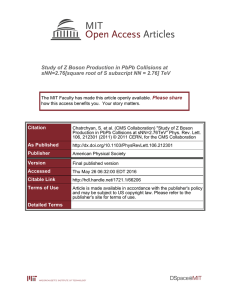
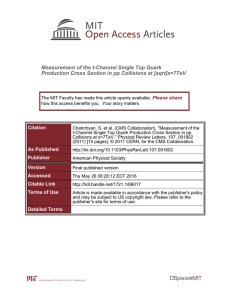
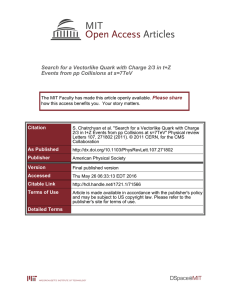
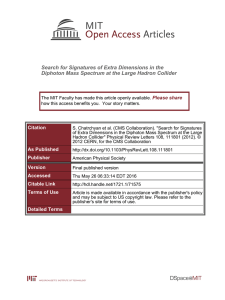
![Measurement of Prompt (2S) to J/ Yield Ratios in... and p-p Collisions at s[subscript NN] = 2.76 TeV](http://s2.studylib.net/store/data/012155530_1-f5b2e1a8e714bfa077d874554e68c6d7-300x300.png)
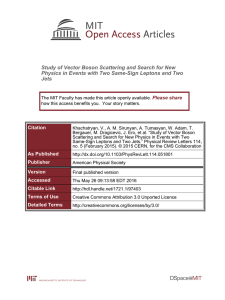
![Measurement of the B[subscript s][superscript 0]](http://s2.studylib.net/store/data/012106816_1-b04183fb8c200db654782451413e2b09-300x300.png)
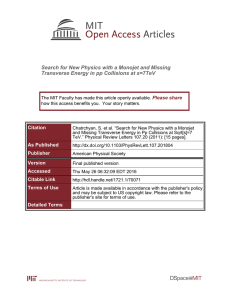
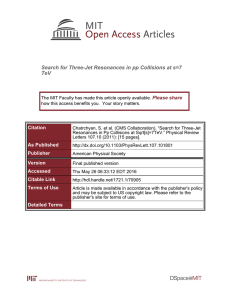
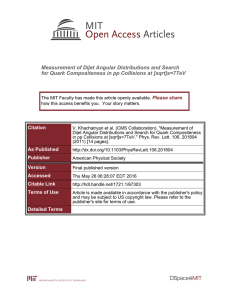
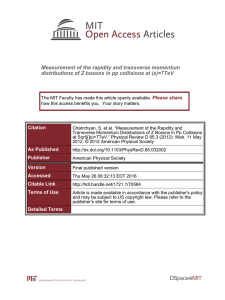
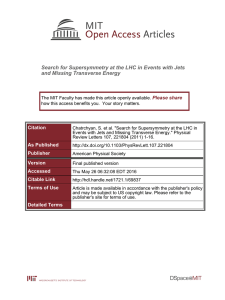
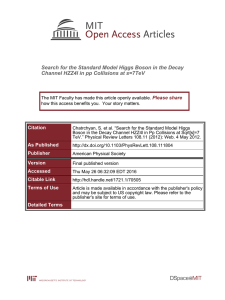
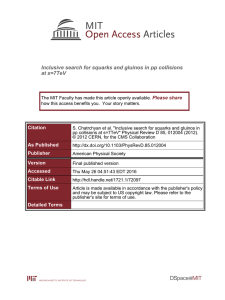
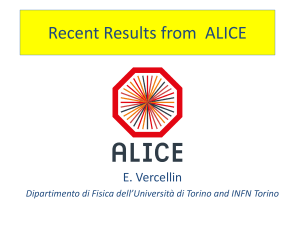
![Measurements of t[bar over t] Spin Correlations and Top-](http://s2.studylib.net/store/data/011743469_1-32d298db4410a621c0ce9c604782da65-300x300.png)
